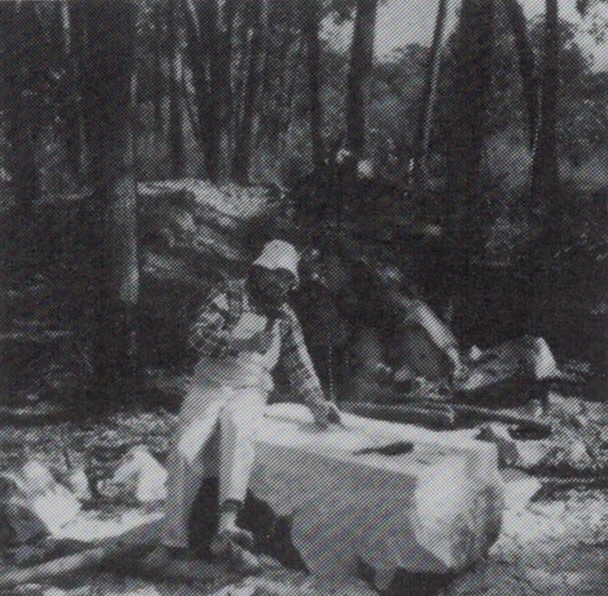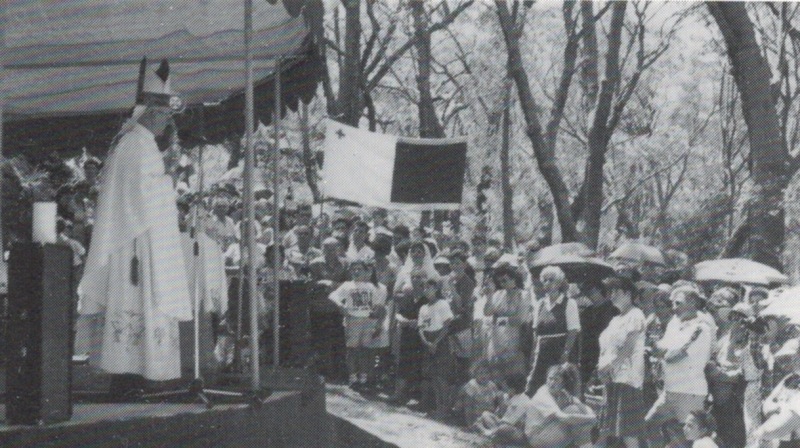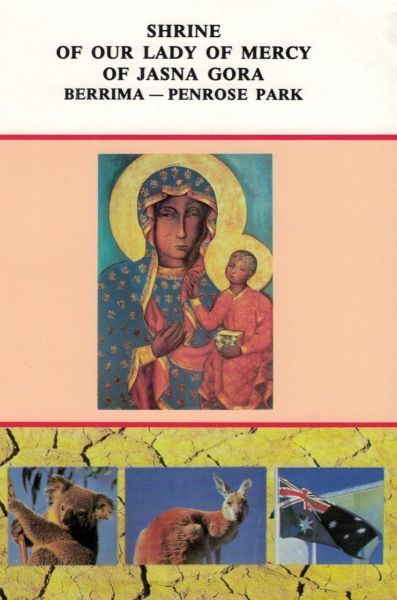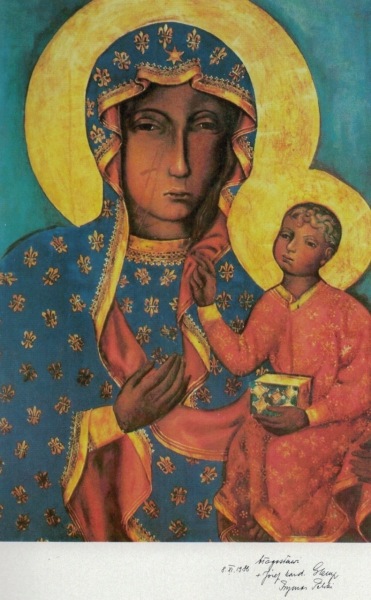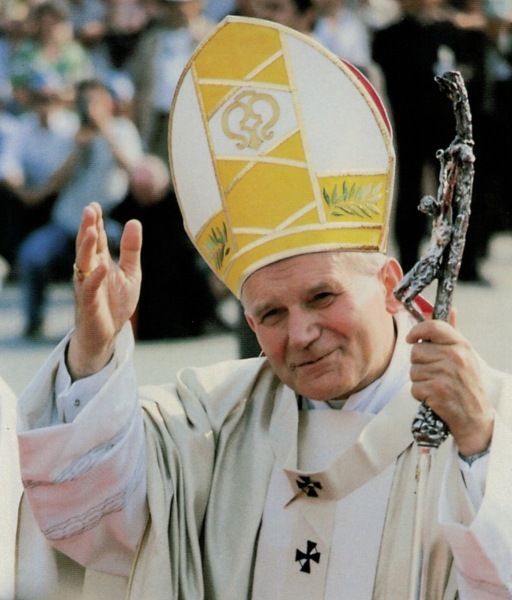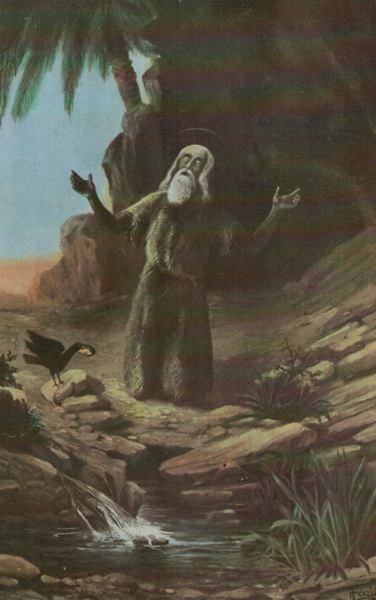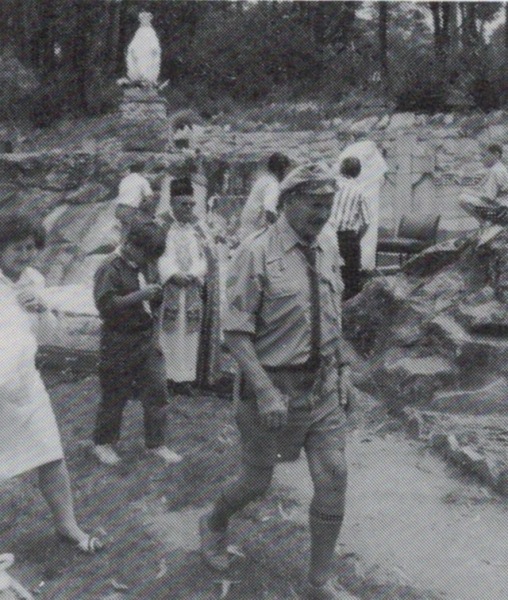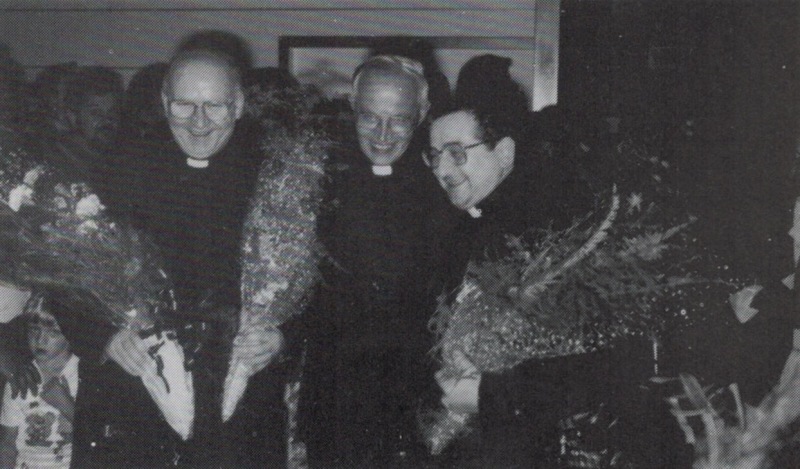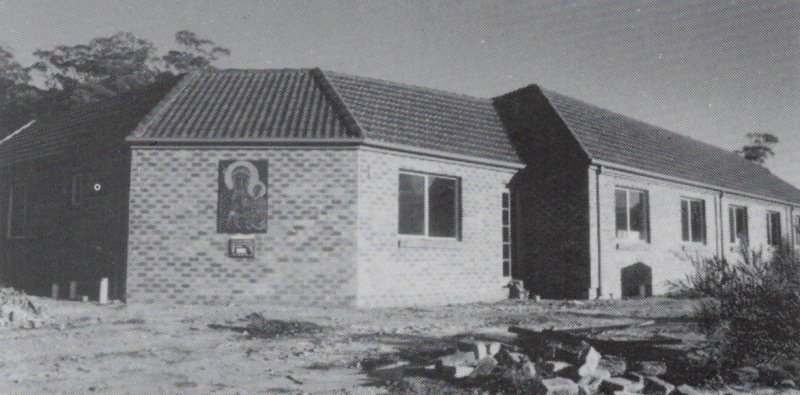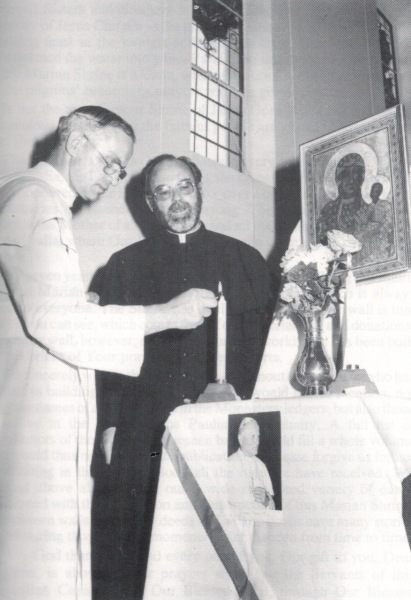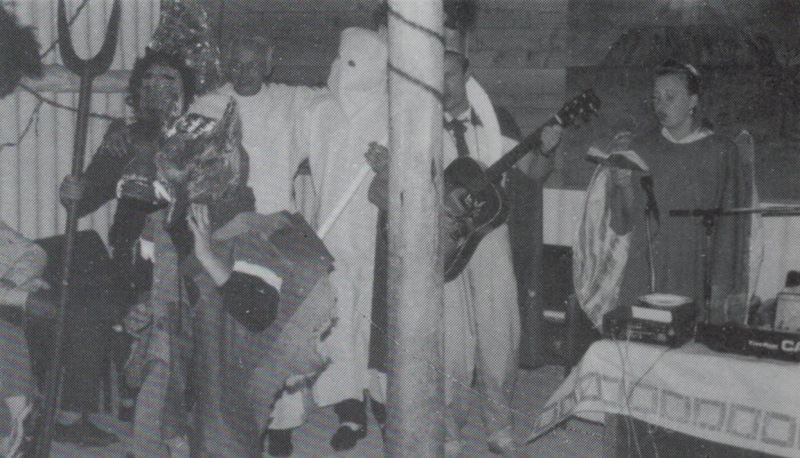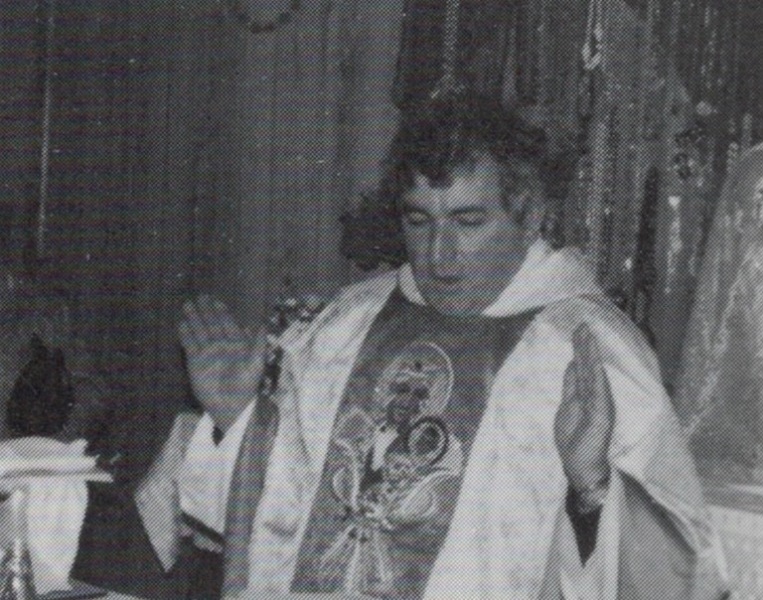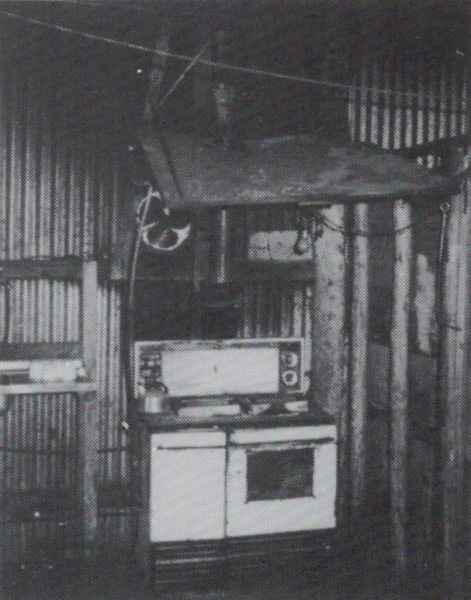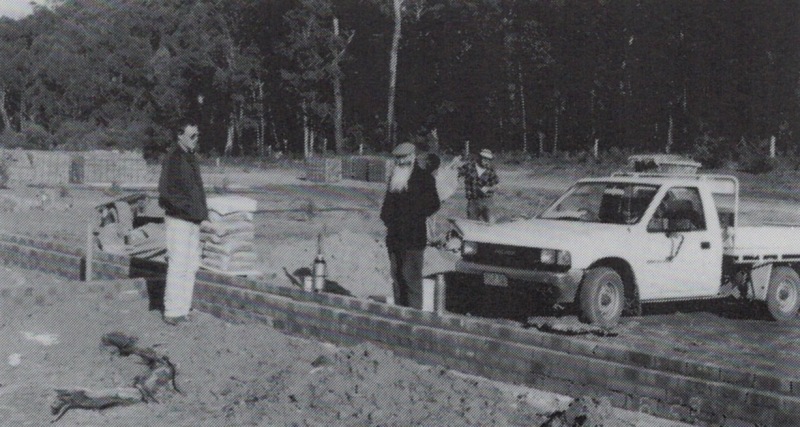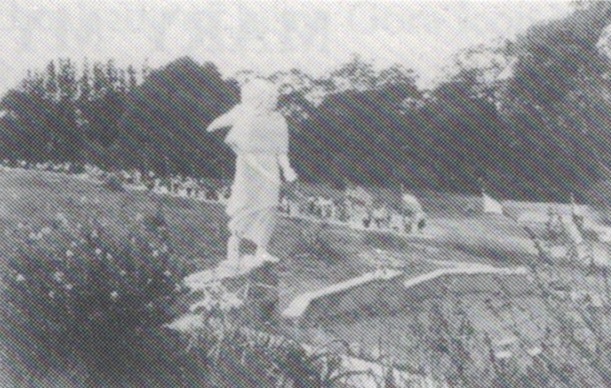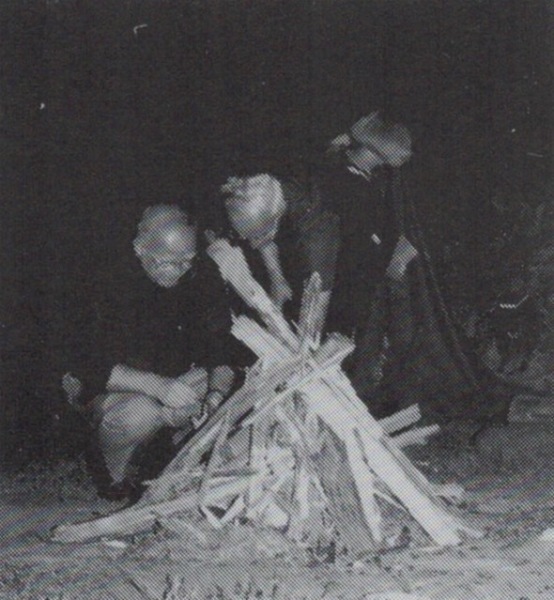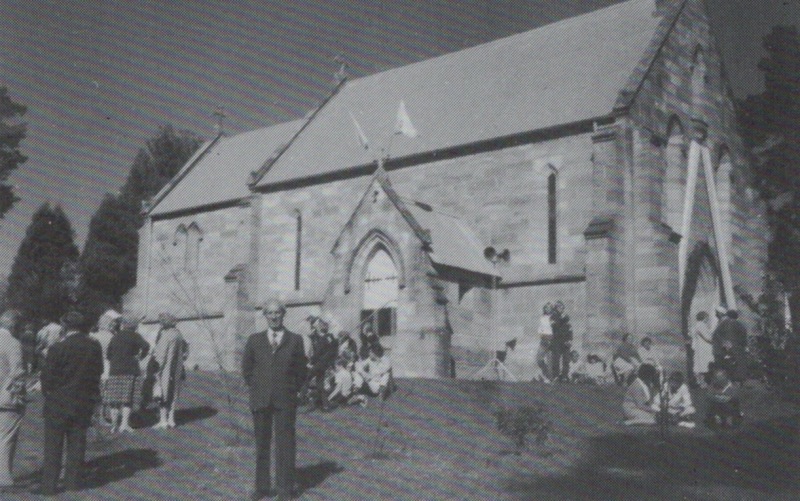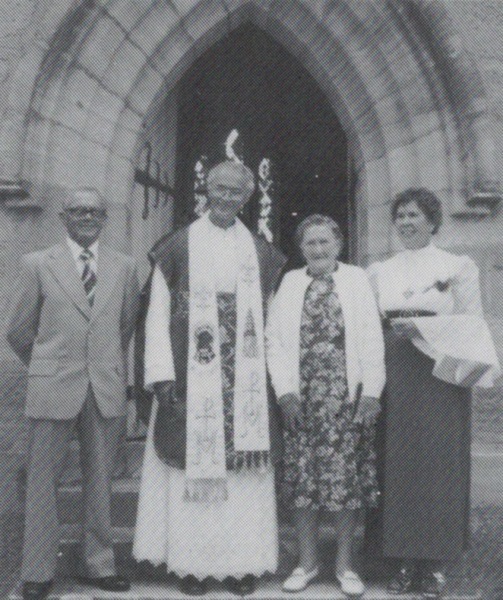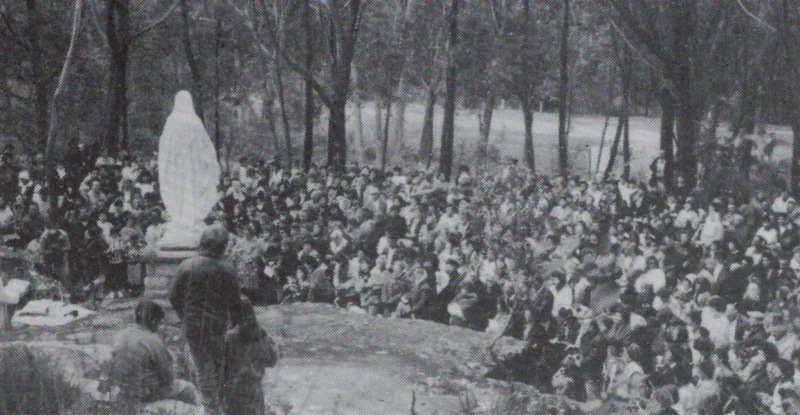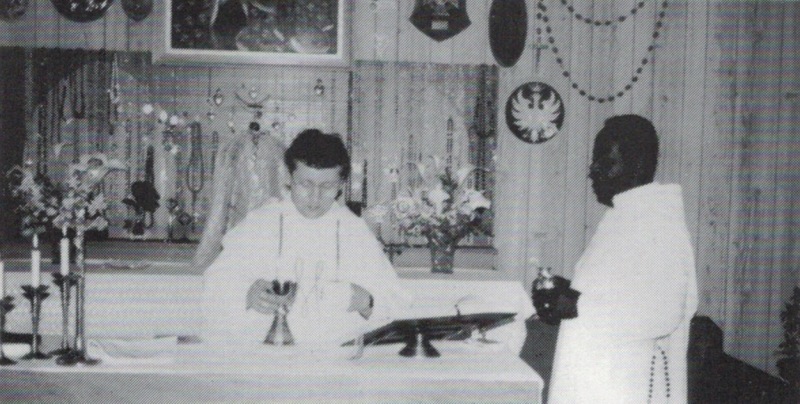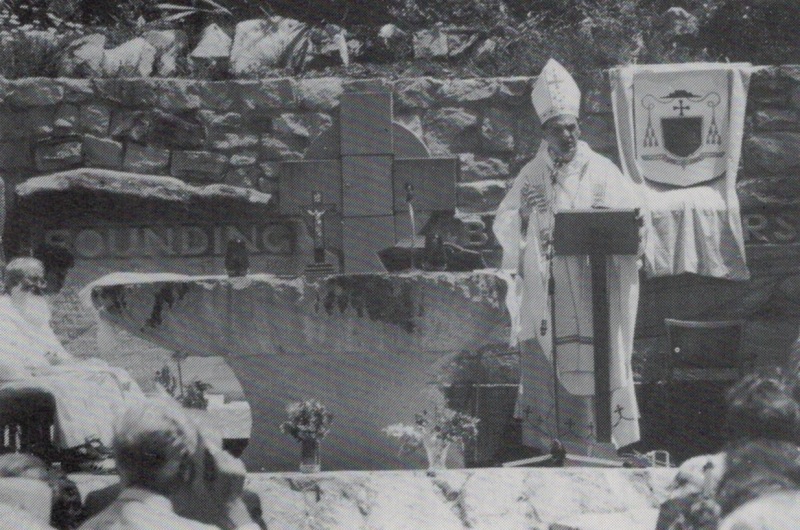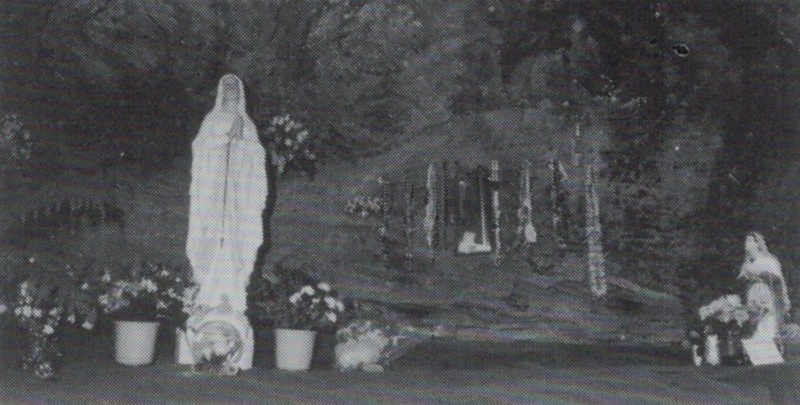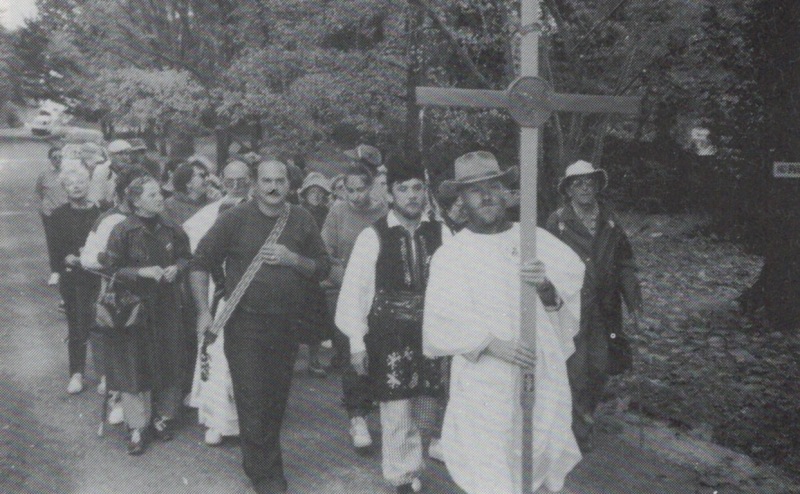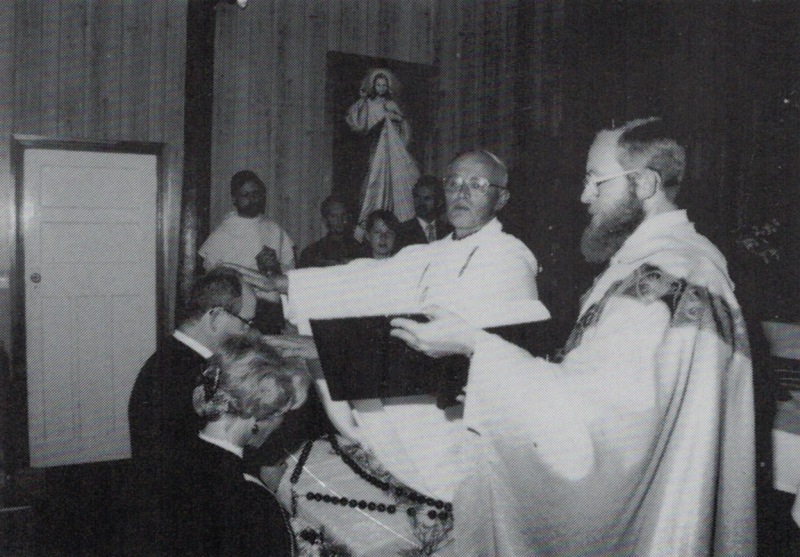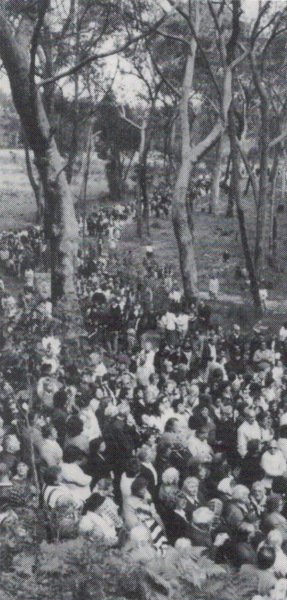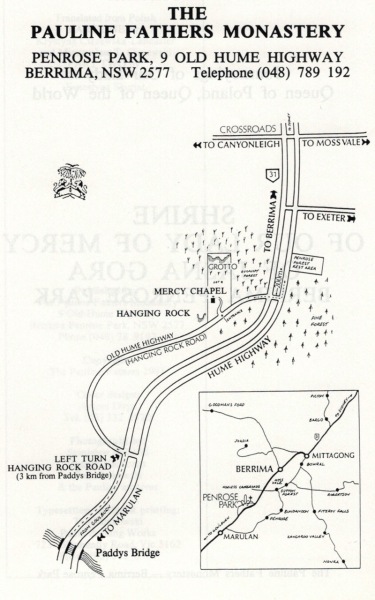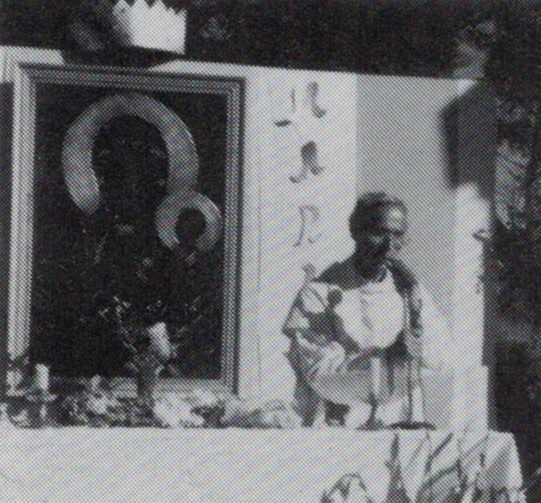The following is from the book on the first ten years of the Pauline Fathers in Australia. It has been edited and reformatted for this online publication.
A scanned copy of the original book can be downloaded from the cover image on the right.
An Anniversary Message
Praise be to the Lord!
Beloved Brothers and Sisters in Christ. The first sign of the public ministry of Jesus Christ was the miracle at Cana in Galilee. During the wedding feast, at the request and intercession of His Mother, Jesus transformed the water into wine. Paralleling this story, we can say that every Marian Shrine is a Cana, where Our Lord Jesus Christ responds to the pilgrims’ beseeching prayers with the gift of Grace. Is not the most famous Shrine of Jasna Góra in Poland just such a miraculous Cana, where the faithful people are granted Divine Grace and Freedom?
That same Jasna Góra Cana radiates to every continent of the World. In Australia, the Lady of Jasna Góra, the Queen of Poland, has already been honoured by the Polish people for over a quarter of a century in the Sanctuaries in Essendon and Marayong. The Jana Góra Lady has become the Mother of all Emigrants and all the inhabitants of the Land of Australia, where Our Lord fills the human vessels with overflowing Grace.
For seven years now, Dear Pilgrim, we have been building this multicultural Marian Shrine at Penrose Park – Berrima, which is always open to everyone. The Shrine has double walls. The outer wall is what you can see and comes from Your material gifts and donations. The inner wall exists in the unseen world and has been built by the bricks of Your prayers and selfless efforts. We sincerely wish to thank everyone – without exception – who has helped in building these double walls. We would like to mention the names of all those noted in the Monastery ledgers and those who live in the hearts of the Pauline Community. A complete list of benefactors of those seen and unseen bricks would fill a whole volume and would thus need a separate publication, so please forgive us for not mentioning in this Jubilee Book all the help we have received. We wanted, above all, to sketch out a wide range and variety of deeds concerned with the foundation and construction of this Marian Shrine. The unseen walls hold many acts and will no doubt have many stories to tell during those special moments which happen from time to time. May God thank every one of you. Our gift to you, Dear Pilgrims, is above all our prayers, which we, the Servants of this Australian Cana, take to Our Blessed Lord through Our Blessed Lady.
May God be with you and your families.
The Pauline Fathers
The Road to Berrima
Dear Pilgrim, the road to Berrima – Penrose Park is the most beautiful. It will continue to inspire you on your every journey. Cast your eyes over the rolling greenery, the valleys where the trees and shrubs huddle together like harvesters gathered for the Angelus. Everything along the road, the tough, dry grasses and the wild sorrel with slender stalks like Gothic towers, beckons you to the shrine.
In Spring, you will see above the rivulets a sea-green veil of fluttering weeping willows, delicate and soft, like the touch of the feet of the Newborn Lord. You will be moved by the sight of the tender eucalyptus leaves sprinkled with the cinnamon of freshness. And when the time comes for the blossoming of the blazing bottle brush, the green landscape becomes stained with the blood of the Crucified One. Yes, take this journey too when the golden light of the bursting wattle blinds you with its splendour.
Oh, Golden Way!
It inspires you most when, after the rain, the rainbow – a multi-coloured clasp – stretches over the highway like a triumphal arch or a brilliant diamond umbrella.
“Sun, Thou art the King of the Earth
(T. Micinski)
Oh Lord God, Thou art the Sun to the World.”
As you turn off into Penrose Park, you are greeted by a wayside copse of birch and, a little further beyond, a beautiful spot of pine – in Autumn, plentiful with the Slavonic delight of Maslaki mushrooms. Here directly by the birch wood, you turn into the side road, which takes you to the hilly place. You will see the sign “Shrine of Our Lady of Częstochowa” and a little further, standing in the solitude of pine and eucalyptus – the monastery.
You may enter. The doors of this house are always open – for everyone. Step inside, and the Pauline Fathers, guardians of the Shrine, with Father Augustine Joseph Łazur as their head, will greet you.
Father Augustine, a man of great humility, simplicity and charisma, now in this year of our Lord 1991, celebrates the 10th anniversary of his arrival here in Australia and of the founding of the first Pauline monastery on this continent.
Don’t ask him how he found his way here or what he has done, for he’ll answer you in his brief way:
“My story is simple.
I came. I am.
Yet, the story of the Pauline Fathers and the founding of the Shrine to Our Lady of Jasna Góra in Australia is long and compelling. Each incredible story of the difficulties and successes of Father Augustine forms a bead in the rosary of efforts in these ten years. And entwined among these stories are those of the faithful who supported this Polish priest from the beginning.
No one documented the struggles of those first pioneering days, months and even years. It is difficult to reconstruct them. Father Augustine is a man of deeds. He prefers to take action rather than talk – and if he does speak, it is only about plans for the future, not the past.
Overpowering Force
But this we do know… Father Augustine Joseph Łazur came to Australia from Doylestown, from the home of the “American Częstochowa”, towards the end of April 1981, after eleven years of pastoral work there. He intended to return to Poland, and he would have had not an overpowering force not drawn him to Australia. On his return journey to Poland, he decided to visit this continent that he had read so much about to find out what it was that this far corner of the world wanted from him. He wrote to the General Curia of Jana Góra for permission. The Curia, after a long silence, wrote back that it was not agreeable to the proposal. Instead, it was favourably inclined to permit Father Łazur to reside permanently in Australia to accomplish something for the Jana Góra Lady.
In effect, he had received more than he had dared ask for. He immediately began to plan for his departure while his mind rejoiced in the dream of establishing a Shrine to the Black Madonna. With a tremendous thud, his head hit the blank wall of the bureaucracy. The Australian embassy reminded him that such trivial details existed as visas, sponsors, documents, signatures, etc. Where was he to begin?
With patience, steadfastness and a systematic progression? He began sending one letter after another to Catholic institutions in Australia. The reply always said, “We don’t need a Polish priest.” But they didn’t know Father Augustine was as stubborn as a wombat. This “wombat’ was not going to give up the fight. He had faith in the Mother of God. He knew he would succeed. Only he didn’t know how many battles he would have to overcome first… He decided to do what he could. He bought an air ticket from New York to Sydney via Warsaw and Rome.
Once in Rome, he fervently knocked on many doors, visiting religious orders which had affiliations with Australia, but none would intercede for him. The trek from office to office did not bring him even one millimetre closer to Australia, but what concerned him most was that his ticket was valid for only a short stay in Italy, and time was fast running out.
He needed to turn his efforts in a different direction. He began a pilgrimage to all the Roman Catholic Churches. He visited eight or ten churches a day, praying zealously before each altar, and would sometimes cry bitterly, not because he doubted but because the road to Australia was proving so difficult.
As he says, he never lost hope. He was confident that one day he would stand on that far-off land and found a Shrine to which the traditional faithful worshippers would come along with many new ones. And so it happened. Our Lady, Comforter of the Afflicted, heard his prayer.
Write To Me
On a day no different from any other day, Father Augustine was at the bus station seeing off a Brother from Jana Góra to the airport. While waiting for the bus, the two were caught in a conversation when a man wearing a cassock interrupted them. The priest, in his haste, had lost his way to the ticket office. Father Augustine offered to accompany him there. With a quick step, they walked 200 metres. And just as they approached the office, the stranger mentioned that he was from Australia.
And so he told him, choking somewhat with emotion, that he was looking for a sponsor. He wanted to tell him everything about his plans but the Australian priest, apologising for the hurry, said only: “WRITE TO ME” and gave him his card. Father looked at the card and could not believe his eyes. The priest whom he had accidentally met was the then Archbishop of Canberra, Edward Clancy – today a Cardinal and Episcopal Leader.
Write to me. Of course, he wrote – that very day. Within 18 days, the reply came. The course of events took a lightning turn. With at last having a legitimate sponsor, Father Augustine hurried to the Australian embassy, where he learned that his permanent residence visa would be ready in two days. And it was! And he managed to leave Italy before his ticket became void.
He landed on Australian soil on the 24th of April 1981. Just at that time, the Census was being carried out. Later the published results showed that for the first time in the history of this country, Catholicism was the leading religion within the community. Mary, Helper of the Faithful and the Dispenser of Grace, was imparting new graces to the faithful in this land.
He landed at Sydney Airport at 6 a.m. There was a domestic strike, and his flight to Canberra was affected. What was this anxious pilgrim to do? Apart from his kind sponsor in Canberra, he didn’t know anyone on this vast continent. He decided to head for the city centre and entered the first church he came to. The obliging pastor of the Anglican church took him to the Polish Centre, which happened to be the Polish section of SBS radio station 2EA (at that time located on Pitt Street by Central Station).
In the small studio sat two fellow countrymen, the then co-ordinator of the Polish program Józef Drewniak and his friend Alojzy Szatadzinski, who was to be one of the Founding Benefactors of the Shrine. Mr Drewniak telephoned Canberra and then escorted the pilgrim to the bus station. In the capital city Father Francis Feruga, a Society of Christ priest, was already waiting for him to take him to the Archbishop’s residence.
There he rested for seven days. He was about to enter a new stage of his priesthood. They were days of marvelling at what had been and was about to be.
Childhood
Joseph Łazur (Augustine was his religious name) was born on the 8th of June 1931 to a devout family in the small village of Kondraty near BitGóraj.
His parents had four acres of land, a horse and two cows. He had seven brothers and sisters. Three had died, and of the remaining four, one sister is a nun in Poland, another sister lives in the USA and his two brothers, Wadystaw and Stanisław, live in their hometown.
Young Joseph spent his childhood on the expanse of Lwów and Tomaszów Highlands, amongst beautiful forests of beechwood, elm, pine and birch, but his childhood was not without difficulties. In the one-roomed cottage lived two families: his parents and his uncle and aunt with their children – eleven people, gathered together in the evenings around an acetylene lamp and later (what a luxury) by an oil lamp. In this tiny cottage, a room was still found for poor wanderers seeking food and shelter. The last weeks before the new harvest was always a difficult time. There was a shortage of everything, especially wheat, so his parents would have to give one day’s service a week to the estate of the Barski family gentry.
Not far from the estate was the school that young Joseph attended, but the Germans came and closed the school and Joseph – not quite ten years old – had to go into service. He looked after the cows, milked them, chopped wood and earned just enough for his board and lodging. After a year, he returned home to help his mother till the soil while his father, who was a joiner, made sleighs and other wooden items. By far, the worst experiences were the terrorist attacks of the ethnic minority bands. At those times, they had to hide in a dugout that his father had made, and sometimes they would look out and see the glare of burning fires and hear the cries of people being murdered. He eventually went back to school in 1947.
In that year, he set off for Lublin. He worked as a cook for the Carmelites and, at the same time, attended night classes, taking two courses a year. And this continued for seven long years.
Joining The Monastery
In the spring of 1954, Joseph started on his momentous journey to Jana Góra with the full intention of joining the Pauline Monastery. He began his novitiate halfway through September 1955, taking on the name Augustine. He first studied in the Metropolitan Seminary of Warsaw and later at the Higher Spiritual Seminary of the Pauline Fathers in Cracow. He was ordained a priest on the 29th of June 1961.
He worked in many places: in Leśniów near Częstochowa, in Leśna near Biała Podlaska; he became rector of a monk’s rest home in Bachledówka Czerwienna near Zakopane. He loved these parts dearly.
Once a month, he would go on longer journeys into the Tara Mountains, and his most beloved place was the Chochotowska Valley. He then became a curate in Oporów near Kutno and later went to Cracow, returning to Oporów as Parish Priest.
Towards the end of 1969, Father Augustine was nominated to go to Yugoslavia, now Croatia, where there were many Pauline monasteries to be handed back to the Order. Father Augustine was to take the monastery of Kamensk into his care. A journey had been planned to Rome… and the plans were changed there in Rome.
During his stay in Rome, the General of the Order in Jasna Góra met Father Michael Zembrzuski, founder of the ‘American Częstochowa.’ A discussion took place from which emerged the fact that America had a greater need for his services than Croatia. And so began his 11 years of work in Doylestown, USA.
First Days in Canberra
After consultations with Archbishop Clancy, it was decided that Father Augustine would start work in the Church of Our Lady of Fatima in Goulburn to establish a Shrine to Our Lady as soon as possible. The calendar read 1st May, the day the Archbishop personally drove him to his first place of ministry as curate and chaplain for the town hospital at the side of Father Henry Burne, the parish priest. The quiet town of Goulburn is situated where the Wollondilly and Mulwaree rivers meet, numbering 22 thousand people. The sheep and cattle breeders live on the plains, cut by ravines and diverse caverns. It’s a town of sheepherders, but nothing like the pictures of shepherds of biblical times.
Throughout his ministry, Father Augustine carried with him, like every member of the Pauline Community, a copy of the miraculous picture of Our Lady of Częstochowa. She was a great source of strength and inspiration. When martial law was declared in Poland, both Father Augustine and Father Henry called upon Her intercession during the special masses for Peace that they celebrated.
You may wonder why the Lady of Jana Góra chose not to make Her home in Goulburn. She was making it known that She was looking for a different place to be Her Shrine. She began Her journey by visiting one site, then another. The first place She came to was a private house in Dapto, south of Wollongong. Lidia and Stanisław Skibicki remember this period well. Stanisław, a friend of Father Augustine’s from his youth and still one of his most stalwart supporters, tells how Father tried to acquire land by the lake in Dapto. Lidia remembers how frugally Father Augustine lived at that time so that he could save his cents in the hope that one day he would save enough to buy some land that would be pleasing to Our Lady. Somehow the land in Dapto didn’t work out – and just as well – for in truth Our Lady loves mountains. She has never told us this, but if you look at the places of her apparitions, you will find that many of them occur in hilly and mountainous regions. Penrose Park is an ideal place with its hills, grottos, and forests – a perfect place for coming to an understanding of being alone with God alone – the Pauline motto.
If you were now to take a map and find the road from Camden to Picton, you’d see a small town called The Oaks. It was here that Father moved from Dapto to take the place of the local parish priest. The church was surrounded by beautiful countryside. Not too far away in Oakdale, there was a perfect place for pilgrimages. There in the bush was a wayside chapel with good seats and a copper icon of Our Lady of Częstochowa, so similar to the wayside chapels of Poland that it gave you the illusion of being in Poland in the mountains. However, it was built by Australian bushwalkers. It’s a beautiful spot. But Our Lady’s journey did not end there. She knew that her home was waiting for her elsewhere.
The Historical Church of Berrima
One day it happened that She set Her eyes on the small Historical Church of Berrima. For ten years, it had stood closed and neglected. But it was there, in this historical town 120 kilometres from Sydney, 163 kilometres from Canberra and 761 kilometres from Melbourne, that Our Lady wished to abide a bit longer.
The Jana Góra Lady took into her heart this beautiful, homely, though somewhat dusty Sanctuary – empty and waiting with expectancy for the faithful.
The Ordinary of the Diocese of Wollongong, Bishop William Murray – a great devotee of Holy Mary – knew only too well that it was right to grant a perpetual lease on the church to the Pauline Fathers.
“O Lord of our churches
(E. Skurjat)
Answer me this question.
Which altar do you wish to call your own –
A newly built one
Or this one,
Dusty, old and worn?
The history of this church is eagerly told by a good-humoured couple Topsy and Bob Dent. Upon retirement, they moved into the area and immediately joined the Berrima Historical Society. They wanted to research the history of the church and neighbouring sites. They explained that the building of this church, one of the first Catholic churches to be built south of Sydney, began in 1849; it was built by convicts – the primary source of labour in those times – and was completed within two years. Its history is linked with the name of Thomas Blacket, an eminent architect of 19th century Australia, designer of Sydney University, and the architect of 58 churches. It was known that some churches were built using Blacket’s existing designs.… but does such evidence exist? We don’t know. Topsy and Bob believe that the present church is a true copy of an Anglican church built in Berrima two years previously, which was, in fact, projected by Blacket himself. Topsy and Bob tell how Berrima’s reputation was growing in importance in those days because it was on the main route to the south. However, its significance diminished with the introduction of the railway line through Mittagong, Bowral and Moss Vale. In those new towns, cemeteries and schools were built, and with time the parish of Berrima emigrated to Moss Vale.
The Church of St. Francis Xavier, which had served the faithful for over a hundred years, was eventually closed in 1974. With a shortage of priests, running this small parish church became difficult. For ten years, the only gatherings that took place were those of the spider – and to think that at the time when Father Augustine was stubbornly persevering with his efforts to come to Australia, he was told that Polish priests were not needed!
The Renovations
With the acquisition of the church, at last, came the hope of once again establishing some form of monastic life. The Prior briskly undertook the renovations. For whole days, for many long hours, he knelt on the stone floor, scraping away at the layers of dirt accumulated over the years. At first, he was alone with a handful of brethren, but the news spread quickly that the master in a habit was wasting away over the renovations. A band of faithful appeared, among them Emma (a Slovenian) and Konstanty Kowalski (a Pole), pioneers of the ‘Berrima Catholic Community’ who too set to work. As the work progressed, there became a greater need for collecting offerings. And thus, donations were collected for the gutters and later for the beautiful stained-glass windows.
Many helped in this pious labour, but as Emma says: “Father Augustine was a better worker than all of us put together.” In September 1983, Father Augustine was ready to leave for Poland to bring back the large copy of the Miraculous Picture of Our Lady of Jasna Góra, through which the Grace of God could radiate from high above the altar of the church in Berrima.
The picture he was to bring back had been purchased for the Australian Shrine by the Koncewicz family from Strathfield. It was painted in Poland by Mrs Dawisz-Beniszowska. Pope John Paul II blessed it during his second pilgrimage to the country of his birth.
The journey of Our Lady to Australia was not without its adventures. Father Augustine had decided to return by the most economical means possible, which meant a train journey to Rome and then by plane with Aeroflot to Sydney via Moscow and Singapore.
Problems had already begun at the Polish-Czechoslovakian border when guards demanded a transit visa and a customs tariff for the picture. No arguments or excuses were entertained; Father was allowed to proceed no further. He had to return to Katowice. It was a Saturday. He set off for the Czechoslovakian Consulate – the gate was closed. However, the janitor, made more amenable by the gift of a couple of dollars, gave him the information he needed – six photographs for the transit visa. It was already after midday, and the train to Rome was due to leave at 8 p.m. Father jumped into a taxi, “To a photographer as fast as you can!” They drove all around the town. Everything was closed. Finally, they found an amateur who managed to do the photographs on the spot. The Prior returned to the Consulate, praying for a speedy meeting with the Consul, who apparently had been fishing and had just gotten back. He turned out to be a most amiable fellow… and talkative – too much so for our dear traveller who was counting every minute.
With the visa in his pocket, Father Augustine arrived at the station ten minutes before the train was due to leave. He quickly reclaimed the Picture and ran along the platform using every ounce of spare energy to cling to the Treasure – the strings around which were snapping one by one, leaving a trail of hanging threads. He jumped onto the train at the last moment. This time the Custom’s Officer didn’t mention the duty – a small victory for, as it turned out, the plane to Moscow had already left Rome, and Aeroflot would not accept the Picture on board as luggage “too big”, they said.
Our patient Lady thus remained in Rome for some time until She arrived in Australia by the Vatican Diplomatic Post.
“She who throughout Her Life was a true migrant, who journeyed within the Holy Icon made in Her likeness over the immeasurable expanses of Europe and Asia… Herself now came to this country, the country of migrants.” This is how Stanisław Skibicki described Her arrival in the monthly edition of Jasna Góra (October 1984). The Lady, with her dark countenance so well suited to this climate, was housed temporarily in Berrima House, waiting for the day of Her Enthronement.
The 13th May 1984
The 13th of May 1984 was the date chosen for the founding of the Shrine, the day when Our Lady of Mercy was solemnly carried into the church. A total of 1500 pilgrims of many nationalities – Italians, Ukrainians, Germans, Latvians, Russians and Poles – all came for the ceremonies that lasted all day.
At 11 a.m., the procession was led by numerous clergy, with the Rector of the Shrine, Father Augustine, and Bishop Murray in the lead. Traffic on the Hume Highway was halted, and the district police kept order. With great pride and emotion, the Girl Guides carried the picture of Our Lady, assisted by many young people in national costume.
Amidst the sound of the Jana Góra fanfare, the picture was placed on the altar in the open air. After a solemnly concelebrated mass, a May Service for the Polish congregation, the Rosary and Benediction, the picture of Our Lady was taken into the church where a place of honour awaited Her. Later this Sanctuary was given greater honour when with Father Higens permission, a special altar was brought from Bowral. Being too big to make the journey, the altar was split in two and then beautifully put back together again to do Honour to the Lady whom it served.
The history of the founding of the Shrine and the Enthronement of the Black Madonna is recorded in the colour photo album of the monastery, which Stanisław Skibicki has been putting together for many years now with great gusto and dedication. From this day, it became the custom for his wife Lidia to prepare dinner for the guests, the bishops and the clergy. During these first difficult years, she would appear with her basket full of dainties and delicious food to feed the pilgrims. These were times when help was needed. And indeed, many did help, each one in their way.
In Volume One of Stanisław Skibicki’s album, under the photograph of the Madonna, there is written this inscription:
“For you,
Oh Jasna Góra Mother of Mercy
Who journeys
From country to country within the Icon,
to save each land,
to save the land beneath the Southern Cross,
for you Oh Mary,
The Pauline Fathers from Jasna Góra
founded and had solemnly consecrated
On 13th May 1984
By Bishop William Murray, Ordinary of the Diocese of Wollongong
The Shrine of Our Lady of Mercy in Berrima –
Penrose Park.”
The name Penrose Park’ was added by its author at a later date. In May 1984, no one, apart from the Lady, Herself, knew that the Mother of God would find Her Home in Penrose Park, in the solitude familiarly known then as the farm.
Meanwhile, the Black Madonna reigned from the heights of the church in Berrima, but the land surrounding the church was barely two hectares in size. There wouldn’t be enough space for the pilgrims nor the building of a monastery. The Lady waited, biding Her time.
The Chronicles of The Order
The Order’s Chronicles began one day before the acquisition of the farm. The first entry dates from the 3rd September 1985. The writer notes that on this day, Prior met with Konstanty Kowalski, Don Luck and others and that the committee for building the Shrine was set up. The chronicle entry ends rather blandly (for was this not of historical importance?) ‘Kon went to make an advance payment.’ The Chronicle does not present us with the atmosphere of those preceding days, full of rushing around looking at everything that was for sale.
Penrose Park stands 750 metres above sea level to the south of Sydney and Berrima – in the direction of Australia’s capital city, Canberra. The farm is situated on a rocky eminence amidst breathtaking forests of eucalyptus and pine. “A perfect place for being ‘Alone with God alone.’ Several grottos provide a special atmosphere conducive to one meditating in prayer.” This is how Damian Maryson praised the Australian Częstochowa in the 1989 October issue of Knights of the Immaculate Mary (Rycerz Niepokalanej).
Emma and Konstanty describe how the farm at Penrose Park immediately captured their hearts. Prior and his companions walked around the 59-acre property four times. Father Augustine liked everything about it, apart from the price. The farm owner (a truck driver) wanted 80 thousand dollars. This was far too much, especially as the whole Pauline fortune amounted to $800! And thus, they walked, brooded, debated, and finally got thoroughly hungry and set off to Berrima House for a snack. They returned to Penrose Park; they walked around the farm a fifth time and declared they must buy it. They prepared to bargain, deciding on a head-on attack. The owner lowered his price, for selling wasn’t easy during the economic recession. He dropped his price again, primarily because he had hit upon a tough customer: when it came to bargaining, Kowalski showed himself to be a master of masters. The price finally stood at 63 thousand dollars. The down payment was made.
Our chronicler wrote at that time optimistically: “Penrose Park is the site for the first monastery of the Pauline Fathers in Australia.” But it was still quite some time before the farm became the property of the Order, for there was no money!
There Was No Money!
The Prior prayed fervently, “Mother of God, I’ve made the down payment; I am not in a position to do any more. I have Faith that You will do the rest.” It was a daring undertaking. Not only was there no money for the purchase, but the deposit required a significant sum. But one’s word had been given… the funds had to be found somehow.
How restlessly and nervously they tossed and turned during those sleepless nights! But all those doubts and fears were without foundation – for offerings began to come in profusion. Donors, with the Kowalski family and Emma’s mother, the late Helen Popovic, offered ten thousand dollars for this cause. A cheque came through the post for 14 thousand dollars from Mr Guzdz, now deceased, from Newcastle. The Mother of God was working her wonders through the good hearts of her faithful. On the 12th of September, Prior could go to Bowral and put the donations into a Commonwealth Bank account, and that same day arranged a loan for 30 thousand dollars. Days passed with more significant donations being offered. Some gave a thousand dollars, others 500, others 100… whatever one could find, one offered. A list of these donors – The Founding Benefactors is carved into sandstone by the open-air rock altar.
On the 17th of September, the good news came that the bank had approved the loan. Now the solicitors could take over. The farm became a reality. The joy was overwhelming. It was indeed a great day and, as such, was celebrated with a bottle of champagne.
Now all that was needed was to wait patiently to finalise the transaction. Feverish days ensued, full of joyful activity. In the monastery’s chronicles, many warming entries capture the atmosphere of those days. There it is noted the daily excursions to the farm. Among the major events are interpolated the minutiae of day-to-day living. Thus, Emma fried nalesniki pancakes and the Prior blessed the newly built home of Mr and Mrs Burns and then drove to Mr and Mrs Kowalski’s house to listen to the radio to see whether the Public Broadcasting Station had announced his appeal to the Polish Community for offerings for the building of the Sanctuary.
Things were getting rather cramped and noisy in the temporary abode of the Pauline Fathers, Berrima House. Mr and Mrs Kowalski brought three transportable gas ovens which would be needed on the farm; Don Luck popped in to say that the painting of Our Lady of Ostrabrama was nearly ready; Beverley Burns appeared with the news that the painting of St. Michael was finished. The constant frequenters from the neighbourhood bumped shoulders with the friends from Sydney – Lidia and Stanisław Skibicki and Margaret and Wadek Kozłowski. It is touching to see a chronicler taking pains over the accuracy of the names, especially Polish ones. From time to time, he would leave a space, for example, by the entry ‘Andrew ________ came today’, to later add the name Krawczyński.
The Farm Became The Property Of The Order
On the 8th of October, The Farm became the property of The Order. But this time, there was no popping of champagne or the sound of fanfares, for there was much to be done. After the formalities, the Prior hurried home to see the bees, whom he suspected were unwell, and to get them ready for the move. It soon became apparent, however, that the bees were fine but that Prior himself was the seriously ill patient. He finally consented to see a doctor but promptly got out of bed the next day to visit a sick elderly gentleman living alone whose cats needed feeding.
Father Augustine began to spend more and more time on the farm. Together with the faithful, he cleaned the area and cleared the bush to make way for new trees and plants. On the 12th of October, he planted some small willow trees donated by John and Anastazja. They formed the beginning of the botanical garden where today, carefully tended, grow a variety of trees, the same as the ones which Holy Mary looked lovingly upon when She was still living in far away Poland. Though all this work was going on, the Pauline Community could not move in until March of the following year, for the house the previous owner had left was an old, run-down tin hut.
The chronicler wrote: “the inside of the shed was in a real mess.” From the walls of this tin structure deprived of windows, one solitary door opened out into the world. Somewhere in the corner stood a bare sink and a blackened oven, above which hung a bare light bulb from a cable. Around the hut, the landscape was mixed with the wreckage of dumped cars, a chicken hut with one rooster and three hens. The impoverished tin hut became the scene of a thorough cleaning. A great battle against dirt and vermin was successfully fought, and a master joiner Peter Spulis appeared in the newly cleaned hut. He and other helpers turned the lowly stable into a warm, dry shelter with six rooms and a refectory with its famous pot-belly stove. Its frequent guests are the old visitors and the new, who, in helping the Pauline Fathers, came to serve the Mother of God.
But most important of all was the building of the chapel – the beautiful home for The Lady of Jasna Góóra. And now to this chapel come migrants from all corners of the world: Poland, Malta, Egypt, Lebanon, Romania… the list of nations is long indeed.
A Most Wonderful Lowly Stable
D. Maryson beautifully commented upon its transformation in Jasna Góra (July 1988):
“Like all new beginnings within the church, the arising of the Shrine was marked by poverty, death and many difficulties… The stable at Bethlehem was itself bare, but God himself made man was there.”
Those who worked hard to create the beginnings of a great religious centre from a shed boarded down with planks of wood came, in fact, here to this Australian lowly stable and not to private, well-furnished homes to celebrate the Feast of Christmas Eve. Mr and Mrs Kowalski, Skibicki, Peszko, Kozłowski and Przyborowski are the people named in the chronicles who began the tradition of celebrating Christmas Eve at Penrose Park.
Christmas Eve is the holiest day in the Polish Catholic calendar. On this particular Eve, with an extra place set for unexpected guests, the whole family gathers around the dining table. Hands trembling with emotion, they break the Christmas wafer, wish each other well, and happy and content at being together, they wait for the coming of Jesus’ birth. They feast on dishes that, while preserving the traditional rules of abstinence from meat, are nevertheless ingeniously delicious: kutia with nuts and honey; pierożki with cabbage; carp in gelatine; mushroom soup; compote with stewed prunes… and beneath the decorated Christmas tree there are presents for everyone – from everyone. Sometimes if you’re lucky, Saint Nicholas, in person, brings the gifts. At midnight the whole family goes to mass together to welcome the Babe with the joyful words “Bog sie rodzi” (God is born).
For many years, this holiest Polish tradition has become a permanent feature of life at Penrose Park. Each year people whose families are in Poland or whose loved ones have died come here. But it is not only the orphaned and lonely who come to the Mother of Migrants, but whole families with their children – all come to partake of the holy Christmas wafer.
Christmas Eve at Penrose Park
Christmas Eve at Penrose Park has an unspeakable magical beauty. Fully in view of the stars, long tables are lined up in the shed, known as the Hall of the Knights (named after a hall of the same name at Jasna Góra) and nearby, ready for the Christmas Eve Mass, stands an altar specially set up for the occasion with splendid green Christmas trees in full decoration at its side.
Strangely, no one makes arrangements to come, but regardless of how many people come, there is always enough food for all. Everyone brings what he can to this communal, holy table. They eat and sing carols, and towards the end of the supper comes a time of light-hearted fun when into the hall parade the carollers in costumes. Grownups and children alike laugh as the devil chases the Prior under the table… from which, after a moment, the white habit emerges, catching the devil by the tail and giving him a beating with a giant rosary, breaking his devil’s fork and demolishing his bony scythe!
Two Midnight Masses are said – one at Penrose Park in Polish and one in English in Berrima. Few people returned to their homes in Sydney, Canberra, Wollongong and neighbouring towns that night. The pilgrims usually stay until the next day at Penrose Park and even a day or so longer. They happily bear the discomforts of sleeping in tents, cars and even beneath a cosy blanket under the stars. Many touched by the words of a carol from the night before become lost deep in thought while waiting for the break of dawn to streak the sky – perhaps a carol like this one?
The Mother, Babe in Her arms
With the strength of Maternal Heart aching
Soothes the soft white limbs of Her newborn child.
And already in anticipation caresses the
Temples, still without thorns.With the shady green of the Christmas pines
She shields Him
From the glaring call of the Cross.
The Pilgrims sing “God is born”
And She sheds a tear
The Garden of Olives draws near.Smile, dear Mother, please smile.
(E. Skurjat)
Why all those tears?
Your Son will grow up, Your Son will die
But Your Son will rise in great glory
And live Forevermore.
Let’s return to the entries in the Pauline diary. In January 1985, the Community of the Pauline Fathers and Brothers constantly journeyed to and from Berrima House to Penrose Park. In both places, there was much work and many guests. The second of January marks the division between the festivities of the previous days and the subsequent busy days of work. It began with the first collection of honey.
Beautiful Marble Altar
Don Luck, our faithful companion, brought the finished painting of Saint Paul the Hermit. Once a computer specialist in the army, Don discovered within himself a gift for painting and has to his credit a painting of Our Lady of Ostra Brama. He is the proud father of seven children, one of whom is also an artist, and although they are not wealthy, Don heads a happy family. Don drove off one day to get some wood for more work on the farm and came across something wonderful. He hurried back as fast as he could with the news that The Sisters of Mercy in Blackheath had a beautiful marble altar to give away, for their convent was being put up for sale… Early in January, the altar was brought to Penrose Park. The diary goes on to say: “The altar is now in the shed waiting for its rightful place in a church” – which with the help of God, will be built by the side of the new monastery. The altar is here – all we need is a church. Just at the time we are writing about, there was a series of jubilee wedding anniversaries celebrated within the Pauline Community. Molly and Don celebrated their 21st wedding anniversary; Mr and Mrs Kowalski their 35th; Eileen and Lech Gade their 25th. However, joyful events were interwoven with sad ones. In New Berrima, Alfred Ware, a venerable old gentleman whom the Prior had been looking after for a long time, was dying. He was taken to hospital and a few days later died. A funeral service with 12 priests assisting was said by his son Father James. Alfred had left his property to the Pauline Fathers. The sum was just enough to pay back the mortgage. Penrose Park now indeed became the property of the Order.
On the 28th of March, the move to Penrose Park was complete. It was the last stage of a journey that had been going on for several months. Berrima House now passed into history. However, the Blessed Sacrament remained in the church at Berrima. It was not until the 16th of May, after an evening service, that it was finally brought to the chapel at Penrose Park, where a fitting tabernacle donated by The Order of The Mother of God Brothers awaited its arrival.
Lord Of Mercy
April 14th saw the introduction of a new form of worship in Penrose Park. At a mass solemnly celebrated in the church in Berrima, the picture of Divine Mercy was blessed, and during the service for the first time in this historic church, the congregation publicly spoke aloud the words of the Polish nun Faustyna Kowalska “Jezu ufam Tobie” (Jesus I place my trust in Thee). This day saw the fulfilment of Father Augustine’s longing, for, at the start of his ministry, he had undertaken to cultivate this worship. Now, masses to the Lord of Mercy are said on the third Sunday of every month. There is a special time for contemplation on the nature of the Mercy of God, prepared by Mr Skibicki in the early days and now by Father Michael Szymanski.
This painting of Divine Mercy was done by the artist Jacek Luszczyk, who came to Penrose Park with this purpose in mind and happily spent his holidays here with his wife and three children. “It was then that I first met Father Augustine. I got the impression that he is a very direct, paternal, quiet person. We, migrants, look for people who are warm, who don’t bite’ ” – Jacek smiled as he said this and then went on, “The sky and the stars are so close to us here, so near. Nature inspires us to be creative.”
With Janusz Niewczas, an artist, he caught sight of a spot by the entrance to Penrose Park that looked like the perfect setting for an amphitheatre. It had originally been a quarry and was now filled with rubble – but with some clearing and cleaning, it became the Shrine to Our Lady of Grace with an altar hollowed out of the rock, and the wall was inscribed with the names of the Founding Benefactors of the Sanctuary. To the right of the altar, a little further away, are the two figures of the Annunciation: The Archangel Gabriel and the Virgin Mary. It was Jacek who sculptured these two figures, and he did so after facing a challenging experience in his life and an artistic metamorphosis. Jacek was born not far from Częstochowa and was brought up by his grandmother, an artist. He completed his studies at the Lyceum of Arts (Liceum Plastyczne) in Kielce and then The Academy of Arts (Akademia Sztuk Pieknych) in Poznan. He arrived in Australia with his family in 1980, where for various reasons, he had to take up work as a stone mason. However, in his spare moments, he thrived on religious literature. Jack’s life then took on a turning point. He started to define himself anew. He discontinued the pursuit for the perfect work of art, for he found more essential values… mankind, goodness… he had found God again, anew.
Stone as Examples of Saintly Beauty
Jacek tells how his work on the sculpture of Mary was a great challenge. He considered how he should present the Jewish girl transfixed by the words of the Archangel. Should he show her as an ordinary human being? Yet She wasn’t ordinary, for She had spoken the words “I am the servant of the Lord. Let it be done unto me according to His Word.’ (Luke, The Annunciation). How to capture the transition from ordinariness to holiness? The sculpture took many months to complete, but that is not the end. Jack’s wish is to place the Angel Gabriel’s greeting in many languages and alphabets as possible on the wall beneath the figures!
Jacek and Janusz Niewczas had attended the Lyceum together, and now Janusz was also devoting much of his time to works at Penrose Park. He arrived at Penrose Park for the first time for the blessing of the painting of Divine Mercy. He observed with what inner devotion Father Augustine said mass and with what great energy he worked. This zeal caught Janusz. He longed to help the Prior in everything he could, especially turning stone into examples of saintly beauty.
His heart was captivated by the farm. “I am not a city person. I am pulled towards nature and am somehow drawn to coming to the monastery chapel to attend mass said here.” During his seven-week holiday break, he painted the picture of St. Peter. He worked in the amphitheatre and built a pedestal for the figure of Our Lady of Grace, which Mr and Mrs Stein from Goulburn had purchased.
This serene figure of Our Lady, full of sweetness, was blessed in January 1987 by Bishop William Murray. He had come to bless the beautifully arranged chapel in the old monastery, and from there, the procession had moved to the amphitheatre in the forest. Here in the open air, the mass was concelebrated by many priests: Father Clemens Hill and the Pauline Fathers; Augustine Łazur, Janusz Pawlicha and Czesław Bieleń.
But let’s go back in time to May 21st 1985. On this day, Father set out for the station in Moss Vale to bring back an unusual guest, Anthony David, who was interested in joining the monastery of the Pauline Fathers and Brothers, and who did, in fact, become the first non-Polish speaker in Australia to be ordained a Pauline monk. One can see that he loved it here, for, in October, the chronicler made the entry saying that Anthony would come again for longer and would stay in the caravan, which was now being made ready for him.
This period also saw the frequent visits of many devout ladies: Caroline Ryman, Maria Chong, Joanna and Julie Keating and Monica McDonald, whose dream was to form the first Community of Pauline Sisters in Australia.
The number of helpers was growing and continues to grow, and you may like to ask whether there are times at the farm when nothing is going on. The answer is No. Work doesn’t stop here even for a moment.
A Sweeping Panoramic View
Perhaps this can best be understood by taking a sweeping panoramic view through the lens of a movie camera over the expanse of Penrose Park and seeing what’s happening there.
Let’s zoom in on the entrance gate to see Mr and Mrs Kozłowski’s truck driving in, laden with furniture that goodly people have donated to the monastery. We move the camera a little further along, and there in the amphitheatre are Jacek and Janusz struggling with a resistant block of rock. Beneath the scene of the Annunciation, the stone wall gradually grows higher and higher as it is built by Wadystaw Łazur, Prior’s brother, on a visit from Poland. On a hillock, with outright Angelic patience, Mr Kowalski repairs the mower, which must have broken down for the hundredth time.
Let’s run the camera along to the Eucalypt forest where Roman Pazniewski is looking for the best site for the new monastery. Watch his return to the stable, take up his spade and start digging in poles that will form the supports for the new garage. This will also be a much-welcomed shelter for the pilgrims coming in ever-increasing numbers and staying for longer periods.
Let’s swing the camera to the right-hand side of the road to see Alf Skirka (our Latvian neighbour) in action with his special machine combating the ferns growing in unrestrained abundance and leaving neat blocks of green waste behind. Next, by the Grotto, see Emma, burnt from the sun, black from smoke and with cuts all over, painstakingly burning off branches, cuttings and trees, as she has been doing for the last few weeks. By her side, Jan Maleszak dripping with perspiration uproots the stumps in the way with his jeep. Back to the house now, to the far corner, to see Andrew Orczykowski, together with an electrician from Sydney, putting in new electrical installations, and a little further away, a master builder is constructing a BBQ that had been planned a long time ago.
The camera’s lens zooms in on the inside of the house to take a close-up of the visitors from Canberra hanging up the curtains they had brought with them as gifts. In the kitchen, Helena Guzdz cooks gołąbki (stuffed cabbage leaves) to feed the tired workers. In the chapel, the tireless Peter Spulis lays down the special flooring. The chapel must be beautiful and neat, for in a couple of days, the investiture of the two Brothers, Anthony David and Gabriel Taylor, is about to take place.
Our Four-Legged Friend
Our film would not be complete without a final picture of our four-legged friend Foxy, who belongs to the Prior. He came here from the home of Max Krajnik, a neighbour who knew the Prior right from the start during his stay in Berrima. As with many others, Max was inspired by Father Augustine’s simplicity and zeal and determined to help build the Shrine. The worship of Mary is just as dear to the hearts of Slovenians as it is to Poles, so Max declared, “Father, I am not rich, but I will readily work with my hands. I have a truck and a tractor, and I will do whatever I can.” Max often visited the farm; one day, he brought a ginger-haired dog. “Why should I need him?” asked the Prior, but immediately realised what a valuable acquisition this would be. And indeed, ginger-haired Foxy can stave off an invasion of kangaroos, wombats and rabbits who would nibble at the stalks and stems of the newly planted trees and plants without him.
One day while walking along a row of birch and pine, lost in thought, the Prior stopped and mused: “I do believe they will grow well, though I must have re-planted them a dozen times. When I die, stand beneath their shade and appreciate how I laboured over these small trees.”
A Botanic Garden
Father loves to work in the garden, planting not only trees but flowers and vegetables too, as he did in the days of his youth. Best of all, he loves to walk here in the early hours of the mornings when the Earth is waking from her slumbers. Father looks at the beds with delight and amazement, saying: “Master, the earth here smells just the same as in Poland!’ On this patch of earth, smelling of the dawn fragrance of Poland, are trees that are found in abundance, both here and in the home country. There are small oak trees, beech trees, white lilac and a linden tree which one day might grow as great as Kochanowski’s Linden Tree, and also the blossoming chestnut brought here as seedlings by Jessie from The Oaks and finally the willows, planted in those first days of the farm.
The Queen of the Earth loves all her children’s trees and every kind of flower. But the heart of Our Lady of Jasna Góra rejoices most in the flowers of the Polish meadows: violets, bluebells, irises, forget-me-nots and daisies. And such flowers as these grow by the Chapel to Our Lady of Grace where the faithful, especially the scouts, come to celebrate the feast day of Our Lady, Queen of Australia’s Flowers. And with this picture of a garden planted, growing, and blossoming, it is fitting to end this account of the first five-year period. A period characterised by its pioneering Spirit: a Spirit of Endeavour; a Spirit that didn’t give in, in hard times and difficult circumstances; a Spirit that inspired people to work together; a Spirit that wanted to create a beginning, a Foundation…
Here at the Shrine of Our Lady of Częstochowa, you see the efforts of human endeavour, an effort greater than the widow’s mite. And because it is our work, this is our place, and we come here to our Mother and our communal Home.
Just recall the biblical mustard seed and see arising out of the Australian bush a Shrine – a Shrine to the Mother of God – a Sanctuary to which we can come and grasp the very hand of the Virgin Lady so that she can lead us in safety along the treacherous banks of our times, to our True Destiny, our True Home.
PART TWO
To be at One with God
From which point would it be most significant to look at the second half of this first decade of the Pauline Fathers’ labours on this continent? From the establishment of the Grotto of Our Lady of Lourdes? Or from the arrival of a young priest from Jana Góra?
It seems significant that these two events occurred at about the same time. On the 23rd of January, 1986, the Prior, together with three Brothers and Monica and Caroline, both Carmelite Tertiaries, went to the far reaches of the Penrose Park property to seek a suitable location for a new sacred site. Unanimously they agreed upon a cave within a prominent rocky outcrop of natural bush wilderness.
This humble grotto was to accommodate the most gracious tenants: Our Lady of Lourdes and her faithful messenger, St. Bernadette. Les and Sybil Stein had found these statues in an old orphanage on one of their frequent trips around the villages. This supportive couple from Goulburn knew that many such items would be required, so they went looking for them.
Sybil had met Father Augustine following a cancer operation in Goulburn Hospital, where he was Chaplain. Father allayed her fears for her future by saying: ‘Trust Our Lady of Jasna Góra, and you will recover.’ He visited her every day, bringing Holy Communion. “I was more eager for his visits than for the doctors’ He is an exceptional person. To me, he is already a saint,” says Sybil, who has had no further trouble for the last nine years, and her doctor has described her condition as good.
Thus a friendship developed. Sybil and Les Stein visited Father Augustine, firstly at Berrima House, then at Penrose Park, bringing little trees and shrubs which they planted and tended themselves, not wanting to cause more work for anyone else. They listened to Father Augustine telling of his vision of a great Marian Centre. They believed he would succeed: “We knew he was a very determined man”. They were surprised, however, by what he had achieved in such a short time and on such a scale.
Father Janusz Pawlicha
Exactly a week later, following the discovery of the grotto, the Pauline Community welcomed the arrival from Jana Góra of Father Janusz Pawlicha. He was to assist the Prior for some time and then take care of the second Monastery and Shrine to be established at Mt. Tamborine in Queensland. Father Janusz touched down at Sydney Airport early in the morning and, en route to Penrose Park, made some stops at Polish homes in line with the tradition that the Polish proverb holds: “A visitor in my home is God in my home”.
Turning from the Freeway into the Old Hume Highway, the Prior asked the new arrival three times if he could see the Monastery and each time, the reply came, “No”. When they came closer, the question was repeated. At that point, Father Janusz replied with some surprise: “I can see a tin shed, but where is the Monastery?” Before he left Cracow, Father Janusz knew he was to work in primitive conditions in the Australian wilderness, but he didn’t realise that what he was going to see was just an embryo of a Shrine.
Father Pawlicha knew from childhood that he would become a priest but a diocesan priest, he thought. Shortly before his HSC, his plans were discovered by the ‘Almighty and Omniscient’ Secret Service. Its officers were tracking down all those who wanted to devote their lives, not to Communism but God. They tried to discourage the young candidates by diabolical measures indeed.
At this time, a Secret Service officer visited him, who made it clear that he could only enter the seminary by agreeing to spy… and even be paid for it. The frightened youth sought the advice of the Parish Priest, who said: “Son, get your HSC first. We’ll worry about the rest later”.
Providentially at that time, Father Augustine came on leave from the United States to visit his native town, Biłgóraj. There, at a Mass, they met. The priest’s attention was drawn to the altar boy, Pawlicha, who seemed particularly pious. For his part, the young altar boy was impressed by how this priest offered the Mass, which was so different from what he had previously experienced.
During the priest’s visiting relatives in the township, they met again. To circumvent the Secret Service, Father Augustine advised the pious altar boy to write an application to the Pauline Order so that he could deliver it personally to Jasna Göra before returning to the United States. So it happened that the plan was realised.
A Group Number Thirteen
Janusz Pawlicha started his Novitiate in 1977. He graduated from the Pauline Fathers Seminary in Cracow and was ordained by Bishop Tadeusz Szwagrzyk on the 23rd of June 1984.
He recalls with emotion the election of Karol Wojtyla as Pope John Paul II. He was a second-year student then. He had heard the results of the conclave during the evening Mass. He recalls: “All the seminarians flooded the streets to herald the joyous news to the city”.
Almost as moving for him was the experience of pilgrimages to Jasna Góra. He walked to Jasna Góra nine times, six times as a seminarian and three times as a priest. Best remembered was a pilgrimage in August 1982 – the first one after the imposition of martial law. He walked in Group Number Thirteen, of which Radio Free Europe later spoke. While entering Jana Góra, pilgrims of Group Thirteen wore a black ribbon bearing a green leaf across their chests. By imposing martial law, General W. Jaruzelski was waging war against the nation, and through mourning, the nation never lost hope of regaining freedom. That freedom was soon to be won.
Sad to say, communist agents frequently infiltrated pilgrimage groups, causing divisions and disorder, as Father Janusz recalls: “A man pretending to be a pilgrim shouted into a microphone for people to come to his rescue as he was being tracked down by Secret Service agents (just to cause disorder), but his ruse failed as pilgrims were already familiar with such tricks”.
Soon after his ordination, as a young priest, Father Janusz was sent by his superiors to Kamenec in Croatia, where he was to take care of a Pauline Monastery. His stay in this beautiful country came to an abrupt end after only three months. The then communist authorities of Yugoslavia held an anti-Church policy. Addressing the priest as Comrade’, the police told him to be out of the country within twenty-four hours. Father Janusz returned to Poland in 1984. The superior of Jasna Góra Monastery then sent him to work in a mountain monastery in southern Poland. However, the young priest was sent to Australia in July of the following year.
His first impressions were a disappointment to him. Only a handful of people attended Sunday Mass at Penrose Park, whereas there were millions at Jasna Göra. However, he didn’t lose hope and was to see steady growth in the flow of pilgrims coming to know of the presence of Penrose Park.
The first long-distance walking pilgrimage on Australian soil was of historical significance to him. A group of enthusiasts had set out on the road, publicly manifesting their faith, hoping this four-day journey would take root in this nation.
On the 13th of October, 1989, the Prior transferred Father Janusz to Mt. Tamborine to establish a Monastery and Shrine in Queensland.
Queensland
Arriving at Mt. Tamborine, Father Janusz found a widely scattered Catholic population in a farming community where a shortage of priests meant a visit only once a week – but things began to change at Eagle Heights. The turning point came when on June 23rd, 1990, a picture of Our Lady of Jasna Góra was solemnly installed over the altar of the church of St. John the Baptist at Eagle Heights. Despite the scattered congregation, attendance at the Masses doubled.
Coming back to the events of January 1986 and the work going on at the Grotto, many volunteers contributed their efforts. Access to the Grotto, which was at some height, necessitated clearing the terrain. The Kowalskis, tireless in their energies, uprooted trees; Italian pilgrims contributed money to construct a pathway over the rocks leading up to the Grotto with a security rail at the edge.
Gracious Tenants
The Grotto, where Brother Gabriel had planted orchids, was soon ready to welcome the gracious tenants brought in by Sybil and Les. Janusz Niewczas repainted the statue of Our Lady and set this on a stable concrete base, and restored a missing hand of St. Bernadette’s statue.
As we read in the Monastery Chronicles, on the 11th of February, 1986, the first group of pilgrims made a procession to the Grotto, thus giving birth to the tradition which now continues of multi-ethnic pilgrimages on the 13th of every month. Under the great canopy of the sky, more and more people sought closeness with God and His Holy Mother.
Father Augustine was required to go to Poland at this time, so the ‘American Częstochowa’ offered help by sending Father Albert to Penrose Park. By sharing the duties, there was more time for work and recreation. Father Janus and Brother Paul attended English classes, but there was also time for picking mushrooms, playing soccer and even playing chess with an altar boy.
The Pauline Community and the visitors spent enjoyable evenings in the kitchen by candlelight as the electricity was often cut off. Father Janusz would chop firewood and light a fire in the room heater, which doubled for cooking a huge pot of maslaki mushrooms. Someone had the idea to bring in a group of newly-arrived immigrants from the Villawood Hostel, where they were still yearning for Poland, unsure of their future in Australia. They came, and happy days were spent on ‘the farm’ with snowflakes reminding them of home. With occasional bursts of electricity, they watched such movies as Our Lady of Lourdes and the Ten Commandments on a video recorder donated to the Monastery by the Łuszczyk family.
Sleeping on a Stretcher
Pilgrim may ask me where all the visitors found space to sleep. Where ever they could find it – most often in the garage, on mattresses, in sleeping bags, on a hammock… and even on a stretcher! The days and weeks passed, and then this idyll was interrupted by drama. Father Albert vanished! He went into the Australian bush and didn’t come back. It was a cold June night. Everyone was running around looking and calling but with no result. The police were called. They searched in vain until three in the morning, returning at dawn to start the search anew.
Meanwhile, the ‘lost property’ appeared where nobody would expect him to be. Father Albert came back at noon right through the main entrance. He said he felt excellent and in good spirits, then he told how he had got lost among the Eucalypt trees, which all looked so much alike to him that he couldn’t distinguish one from another. He slept the night, shivering, in the bush only to find out in the morning that he was somewhere near Canyonleigh, and a good man gave him a lift to Penrose Park. Father Albert departed for the United States on June 13, 1986.
The return of the Prior was yet another two months away, and his faithful dog, Foxie, turned sad eyes towards the highway, often leaving his food untouched. The Skibickis brought Father Augustine from the airport on the 31st of August, and the welcomes continued for some time, with Foxie outdoing himself in high jumps.
After Prior’s return, a series of significant events regarding the future of the Monastery and Shrine occurred. The investiture of Brother Joseph Hession took place in mid-September 1986. This coincided with the 40th Wedding Anniversary of his parents, which was also celebrated at the same Mass. The publicity given to the two celebrations was advantageous to the Shrine. The Prior, accompanied by Brother Anthony and Brother Gabriel, travelled to St. Paul’s National Seminary at Kensington to arrange their enrolment. The outdoor Chapel of Our Lady of Grace which resembles an amphitheatre, was just beginning to be established at this time.
Visitors, Visitors
In November 1986, streams of visitors stopped by the Monastery for a drink of the famed Penrose Park bore water, excited about a significant event they would witness. This was when the Polish-born Pope John Paul II made his Papal tour of Australia. Some were on their way to Canberra, where the Pope was to celebrate a Mass. But most Poles went to Melbourne for a special Mass that brought together the Polish Catholics of Australia with their beloved brother and distinguished guest, the Holy Father.
Speaking of visitors, there were many, both clerical and lay. Working in Goulburn at this time was Father Wally Stefanski, who often came to Penrose Park but who now is the Parish Priest of Jindabyne. He recently organised a festival honouring Sir Paul Strzelecki, the great Polish explorer. Other priests, Jan and Jerzy Chrzczonowicz, came to visit, sometimes assisting the Pauline Fathers with their ministry. Now and then, a priest of the Little Opus of the Divine Providence Order, Father Stanisław Skibicki, came… a personal friend of the Skibickis though not related.
Priests of the Polish Catholic Mission in Bankstown (Society of Christ) with the Rector, Father Stanisław Wrona, made several visits. Bishop Pat Power of Canberra came and led a procession to the Grotto of Our Lady of Lourdes. Vacationing Polish priests from Oceania came also. Religious Sisters of various orders from all parts of Australia and people from all walks of life came to the Shrine seeking the warmth and love of Our Lady of Jana Góra. Journalists were also drawn here. Polish television producer Andrzej Chiczewski filmed a story on Penrose Park to be screened in May this year. Jan Dunin-Karwicki, editor-in-chief of the Polish News Weekly, came several times in earlier days. Stanisław Kotowicz, who is associated with the Polish News Weekly, makes regular pilgrimages to Penrose Park.
The authoress of this book, a journalist of SBS Radio 2EA, finds the Shrine a place of renewal and inspiration. The list of visitors would not be complete without Helena O’Neill. She came to Penrose Park with Italian pilgrims two years ago. On seeing how much work was yet to be done, she offered her secretarial skills to the Community and has been assisting the Prior ever since.
The Rosary – A Grace of God’s Mercy
A Rosary Garden, the idea of the Prior, was developed by Jacek Luszczyk. The design, an outer circle of rose bushes of various species and colours, encloses a Rosary that comprises the decades of rose-shaped white-washed medallions that are spaced like stepping- stones and, in total, form a heart. Where better to ponder the mysteries of Jesus’ life, taught to us by Mary, than in a rose-perfumed garden of beauty?
O! Flame of Love!
Michael Taylor
Inflame in us the love you bear for Christ,
Bring us to Him
As babe-in-arms He was,
Cast aside the swaddling of our sins
So we too might forever dwell
Within the shelter of His loving grace.
(Family Magazine, March 6, 1985)
The Rosary Garden was blessed during its first procession on the 4th of October. On this occasion, a banner in honour of Our Lady Queen of the Holy Rosary was presented to the Shrine by the Ciszewski family of Canberra. At the initiative of this family, the book ‘Gallery of the Roman Pontiffs‘ was produced and published to raise funds for the building works of the Shrine.
The Feast of the Immaculate Conception was celebrated on December 16, 1987, making it a summer festival in Australia. Polish Scouts have traditionally hosted this occasion at the Chapel of Our Lady of Grace, led by their Scoutmaster, Witold Szupryczynski. Along with flowers, the Scouts offer their Mother their hearts, joys, pains and hopes as the faithful of Rome do.
Patriarch of The Order
To honour St. Paul of Thebes, a Solemn Mass was concelebrated on January 17, 1988, with Bishop William Murray as the main celebrant, assisted by Father Augustine and Father Janusz. A choir from Sydney, Tecza – meaning Rainbow’ – gave added majesty to the ceremony. Following Mass, the Relics of St. Paul were venerated.
Born in Lower Thebes around 228, St. Paul lost both parents when he was sixteen. He and his sister inherited great wealth but enjoying it was not his destiny. As Christians were being persecuted, he had to hide in a countryside property. He could not stay there for long because his brother-in-law, whose aim was to control the inheritance, threatened to report him to the persecutors.
St. Paul fled to the desert and, for the love of Christ, began to live a new style of life of prayer and solitude… the life of a hermit. He lived in the grottoes, which made a secure hiding place. He didn’t have much, but at the same time, he had everything he needed to live.. stream water and dates. His biographer, St. Jerome, wrote that St. Paul spent as many as ninety-seven years in the desert. When Blessed Eusebius founded the Pauline Order under the patronage of St. Paul the Hermit in the thirteenth century, it revived Christian piety for this saint.
Solus Cum Deo Solo
Alone with God alone. This is the motto of the Pauline Order. The Monastery was first established in Hungary in 1215. The Order moved to Częstochowa more than a century later by decree of Louis the Hungarian, the then King of Poland. Prince Wtadystaw of Opole, a relative of the king, brought the Paulines to Poland in 1382 and established a monastery next to a wooden church on Jana Góra. Two years later, the Duke of Opole brought the Icon of the Black Madonna to Jana Góra from Ruthenia. Following a battle, he found the image in a chapel of the Betz Castle in Ruthenia.
This priceless picture is one of the oldest images of Our Lady in the world. According to legend, it was painted on the top of a table of the Holy Family by St. Luke. In 1430 the Icon was slashed by the swords of bandits, leaving two long scars on Our Lady’s face even after the restoration of other damage.
In 1655 the Black Madonna saved Poland from the Swedish invasion, after which the King, Jan Kazimierz, declared her Queen of Poland and Patroness of the Nation.
Jasna Góra is one of the world’s greatest shrines devoted to God’s Mother. It is visited by at least two million pilgrims a year. Traditional pilgrimages to Częstochowa take place in the summertime, mainly in August. From all over Poland, Europe and the world, her children go to see their beloved Mother.
Marian Year 1987 – 1988
The Marian Year aimed to prepare the faithful of the world to enter the third millennium of Christianity, and it brought the tradition of long-distance walking pilgrimages to Australia.
Home to immigrants of diverse ethnic groups, Australia celebrated two hundred years of European settlement in 1988. Quoting Andrew Huntley in the Catholic Press: ‘Penrose Park and its Shrine represent an extraordinary marriage of Christian Europe and Australia’. The April Marian walking pilgrimages have become a fixed item on the Penrose Park Calendar of Events.
Like any tradition, it had to start one day because of someone or something. Lidia and Stanisław Skibicki were its first initiators. Stanisław was a colleague of the young Augustine during seminary days, and when they met again in Australia after many years, the providential encounter sealed the friendship. The Skibickis visited Father Augustine in Goulburn, Dapto, The Oaks, Berrima and Penrose Park, faithfully supporting him wherever he went.
In April 1988, the Skibickis were celebrating the twenty-fifth anniversary of their wedding. In thanksgiving and regarding the Marian Year, they wanted to go on a pilgrimage to Częstochowa, but the costs were beyond their resources. So it was that they decided to make their pilgrimage from St. John’s Church, Campbelltown, to the Shrine at Penrose Park. To encourage others to join them, they formed a pilgrimage committee.
And So It Began
Towards the end of April 1988, they set off a group of fifty pilgrims that included ten Australians. Always leading the way and in the best shape was seventy-five-year-old Henryk; the youngest was six-year-old Annie. Father Janusz led the Polish group, and Brother Gabriel, the Australian group. On the first day, pilgrims got acquainted; the Australians asked many questions about Jana Göra and its traditions.
A pilgrimage is not specifically a Polish or even Christian tradition. From time immemorial, pagans, Muslims and Christians set out on pilgrimages. Our pilgrimages derived their meaning from the fall of humankind when Adam and Eve were cast from Paradise. A wanderer on the earth far from their home with God, the Christian pilgrim seeks the way back.
As we read in the Old Testament, the Jews made their annual pilgrimage to Jerusalem with the aim of repentance and purification. At the beginning of the Christian era, Europeans made pilgrimages to the Holy Land, and medieval sinners wore penitential rags. In ancient Poland, the faithful made pilgrimages to the tomb of St. Adelbert at the site of his martyrdom and to the Marian Shrines. Pilgrimages to the miraculous Icon of the Black Madonna began soon after the opening of the Monastery of Jasna Góra.
A Pilgrimage – A House Built of Love
On a pilgrimage, the pilgrims become one large family, calling each other ‘Brother’ and ‘Sister’. Pope John Paul II encouraged us to build such houses of love, especially during the Marian Year he declared. This Year began on June 7, 1987, on the Feast of Pentecost and concluded on August 15, 1988 – on the Feast of the Assumption. In a pilgrim’s notebook describing the first Marian walking pilgrimage, the observation is made: “The landscape is so magnificent; God created all this. How could we not love Him?”
In the hearts of the pilgrims was the Kingdom of joy, and by contrast, in the faces of the passers-by not entirely familiar with this demonstration of faith, a variety of expressions could be seen. Janus Niewzas recalls seeing indifference, curiosity, and interest; some young people just laughed at them. Some seemed critical, thinking they would be better working than loafing. All this brought home to the pilgrims the words of St. Paul: “We preach Christ crucified, a stumbling-block to the Jews and folly to the gentiles but to those who are called, Christ (…) (is) the power of God and the wisdom of God”. 1 Cor. 1:23-24
However, as one of the pilgrims noted, this was not a frequent experience: “People are looking at us with interest and smile approvingly. Cars slow down and honk a hello”.
The central elements of the pilgrimage are the celebration of the Eucharist and praying together… the Little Office of Our Lady, the Jasna Góra Pledge, the Divine Mercy Chaplet and the Rosary, and the Way of the Cross. The priests gave teachings and reflections, while moments of relaxation are held when pilgrims sing and joke. Someone wrote
In A Pilgrim’s Notebook
It is written in a pilgrim’s Notebook that in Father Janus’s first homily, he preached on overcoming evil with good. These words of St. Paul became the motto of the first pilgrimage. The same words were the motto of a Polish priest, Father Jerzy Popieluszko, whom Secret Service officers murdered in October 1984.
On the second day of the pilgrimage, the first signs of discomfort were evident: blisters, cramped muscles, aching limbs, and sore feet. These were tended mercifully by Lidia and Janina. Despite all their pains, spirits were high. “Passers-by seemed very surprised to see bandages on our legs yet smiles on our faces”. Their discomfort was such that some of the pilgrims missed a meal on the third day just to have a few minutes to lay down with their feet elevated.
“Amongst the grasses
(T. Micinski)
faint I lie
motionless –
like a glassy pond”.
The six-year-old daughter of Ursula, Annie, felt weak and was sometimes driven in the car though the adults didn’t feel much better! “We were going up a hill, and it was my turn to carry the cross; it was then that I understood how every little movement caused so much suffering to Jesus. Even though my back wasn’t whipped nor my head crowned with thorns and nobody told me to carry THE cross, I felt for the first time in my life that I was making the way of the Cross”.
The dawn of the next day brought the fourth day of the pilgrimage. “We’re smiling much less probably due to tiredness, but on the other hand, a real charity was growing as evidenced in the concern each one had to relieve the other’s pain. What had become important was to think more of others than ourselves”.
Near the end of a pilgrimage in Poland, pilgrims stop at a ‘hill of forgiveness’, asking pardon of each other for offences. The word. ‘forgiveness’ gained a more profound meaning here. Father Janusz related how in Poland, if one didn’t forgive another, they had to carry large stones until they did.
Forgiven and at peace, they carried on. With the Shrine only one and a half kilometres away and with shoes off
They Walk on Sore Feet
Ursula’s son, Chris, asked: ” Why so?” She tried to explain the meaning of it. He must have understood, for a knowing smile appeared on his face.
The Prior welcomed all the pilgrims, leading them into the chapel where they prostrated themselves before their Mother.
“This is where all praise Her greatness.
(W. Pol)
All are lauding Her and bemoaning their sorrows”.
The tired pilgrims rested before Her in silent prayer, then arose to her majestic and penetrating gaze. The scars on her face bespoke not only her sufferings at the foot of the cross but also the whole martyrology of Poles and the efforts and toils of all people through the ages.
The pilgrims moved to the shelter shed in Polish, the ‘Knight’s Hall’, for a specially prepared dinner. The Prior attended to the pilgrims, moving around the tables, waiting on them, encouraging them to eat, and speaking personally with each one. “To serve is to reign”. For him to assist others was a privilege. One of the pilgrims had written in a notebook: “There is so much warmth and kindness on his face”.
The final blessing of the Blessed Sacrament crowned the efforts of the fourth day, and later that evening, gathered around a bonfire, they sang in thanksgiving to acknowledge the contributions made by Janusz Niewczas for filming, Elizabeth Luszczyk for food provisions, Janina Matecki and Lidia Skibicki for their samaritan care.
The walk had ended, but there was still day five of the pilgrimage. On this day was celebrated the fourth anniversary of establishing the Shrine of Our Lady of Mercy. The main celebrant at this Mass at the Berrima church of St. Francis Xavier was Father Schnitzer of the Diocesan Chancery in Wollongong, with Fathers Augustine and Janusz concelebrating. The Tęcza choir from Sydney added splendour to the ceremony.
The blessing by Pope John Paul Il of the participants of the first Marian Walking Pilgrimage was a great reward for the pilgrims. The original document is proudly displayed in the Monastery.
Penrose Park is, first of all, a place of prayer and devotion, but there is also a place for relaxation and entertainment. Now and then, concerts are enjoyed as on this Sunday after the Mass in Berrima. After the faithful returned to the farm and were seated around the statue of Our Lady of Grace, they listened to Marian and patriotic songs led by the Polish Social and Cultural Association.
Thus the pilgrimage ended late that night when the Southern Cross appeared in the sky to show them the way home. They departed joyfully because in these five days, they had rediscovered Christ, and their faith had been strengthened, as Ursula wrote: “To believe and to hope are the two most important things in human life”.
An Incentive For Future Pilgrimages
So the first walking pilgrimage to the Shrine of Our Lady of Mercy had become part and parcel of the religious history of this continent. Father Janus had an article published in the Polish News Weekly where he shared his impressions with the readers and thanked the initiators and the untiringly devoted organisers. He emphasised that everyone who participated was a hero and heroine. This article was to act as an incentive for future pilgrimages.
To quote Father Janusz: “Those who walk through life without spiritual guidance risk losing the way, falling down and remaining there. A pilgrimage helps us reach the heights, shows us the transience of this life, and reveals the working of God’s activity in us”.
The second Marian walking pilgrimage lasted from April 19-22, 1989. Forty-seven adults and ten children took part. Their ages range from four to seventy-six years. They covered the distance of 111 kilometres in four days, as reported in the Catholic Weekly with the heading, ‘Modern Pilgrims honour Mary’. The Polish group was led by two Polish priests, Father Janusz and Father Stanisław Skibicki, who also celebrated the tenth anniversary of his ordination at Penrose Park. Brothers Gabriel and Anthony led the Australian group. The theme of the second pilgrimage was – “Jesus Christ is the source of our faith and hope”. Bob Mitchel added a new dimension who sang spiritual songs in English; later on, his guitar and voice were often heard in Masses at Penrose Park.
Quoting The Catholic Weekly, at the end of the second pilgrimage, the Solemn Mass… “was celebrated by Bishop William Murray of Wollongong to mark the fifth anniversary of the blessing and dedication of the Shrine of Our Lady of Mercy of Jasna Góra’. A caption under a photograph in the Monastery album notes that even heavy rain didn’t stop the attendance at Mass. With this last of their prayers in common, the pilgrims parted without any regrets; it was the beginning, not the end, as a new incentive was to bring them together again. Ongoing Pilgrim’s Meetings on the second Sunday of every month would continue.
The Third Walking Pilgrimage
This took place from April 23-29, 1990. Perhaps the most important comments on the walking pilgrimages are to be found in the notes of Teresa Wyszynski of Canberra: “A spirit of multiculturalism is present in these pilgrimages”. Teresa reminds us that Professor Jerzy Zubrzycki of the Australian National University is the father of the concept of multiculturalism. His theory is that each nationality brings the best of its culture to form the global basis of Australian culture.
What could Poles contribute to their new homeland? From their rich religious inheritance, it was notably their Marian spirituality with the beautiful traditions associated with it that could add to the Australian scene. On the foundation of those traditions brought from Poland, new forms began to take shape; for example, the Feast of the Queen of Australian Flowers; the popular pilgrimage on the 13th of each month honouring Our Lady of Fatima; taking home Holy Water as is common at Lourdes.
Sad to say, absent now is Rajmund Dopierata, who was dedicated as organiser and participant of the first three walking pilgrimages. He died in an accident in 1990. May he rest in peace.
Apart from the annual walking pilgrimage and the monthly Fatima Day pilgrimage, a full month-by-month programme for the entire year exists. Besides these, family groups bringing a sick member along, special interest groups or even individuals come and follow their pilgrimage exercises. On the first and second Saturdays of every month, Polish Sydneysiders come for a one-day pilgrimage organised by Mrs Zenia, Mrs Sawicka and Mr Zawadzki. Stanisław Kotowicz, for years now, has been promoting the Shrine by doing all that was necessary to get the finished article through all stages of publication with the Polish News Weekly.
The Visit of the Primate of Poland
One event that ranks second to the Papal visit that needs to be highlighted in this anniversary publication is the visit of the Primate of Poland.
In November 1988, Josef Cardinal Glemp visited Polish communities all over Australia. He had heard a lot about the Shrine in the bush and wished to make time in his busy schedule to pay a visit to Penrose Park. He arrived at the farm early in the morning on the 8th of November and was introduced to the great designs planned for this Shrine. Most significantly, he blessed the foundation stone for the new Monastery and Church that would be built in the future.
Among the many trees and shrubs planted on the property, there was an Oak that had been nursed lovingly in its struggle to survive. The most cherished memory of the Prior was when the Primate stood next to it and sighed as if, surveying the landscape, he desired to stay longer and respond to the appeal he seemed to feel for the Australian bush. Knowing that this so short a time was all he would have here, he absorbed the unusual combination of scents from the Pine and Eucalypt forests around him.
As it was, the distinguished guest had to leave for Canberra that same day. In the evening, celebrating a Mass for the Polish community there, Cardinal Glemp spoke glowingly of the bold plans for building a shrine in the bush. He expressed his conviction that more and more pilgrims from all over Australia would be attracted to this Shrine. He said that he hoped that the warmth of Our Lady would revive the fervour of faith in those who came.
Visitors From Jasna Góra
One other significant visit was visitors from Jasna Góra. From January 19 to February 9, 1990, two delegates of the Father General for the Pauline Order visited Penrose Park. Father Stanisław Turk (Procurator General) and Father Melchior Krölik (Secretary General) brought a gift from the Father General… a picture of Our Lady of Jasna Göra painted by Anna Tortwirt. This picture will occupy the place of honour above the marble altar of the new church yet to be built next to the new monastery.
Amongst those who cordially welcomed the visitors was Janusz Niewczas. He met Father Turek during his pilgrimage to Rome in May 1989. During their long conversations, the idea formed of carving an image of Our Lady in granite. Now completed, this decorates an exterior wall of the new monastery.
Janusz, encouraged by Father Turek, viewed many slides and photographs of the Madonna in black granite at the Jana Góra cemetery. While carving this image, Janusz was apprehensive of the outcome, as it was the first time in his life that he had attempted to create a three-dimensional effect in stone. On the 9th of September, 1990, the image was blessed, and a visiting artist from Poland, Tolek Jablonski, gave a concert.
The First Australian Pauline
Some significant events occurred in 1990 concerning the consolidation of the Pauline Order in Australia. On January 7, Anthony David took his final vows, thus becoming the first son of St. Paul from this continent. He was ordained to the Diaconate on the Feast of St. Paul a week later. His ordination to the Priesthood was to take place in August.
In March, Father Augustine had to leave for Jasna Góra to participate in the election of the General of the Order. This resulted in Father Janusz Nalaskowski becoming the new Father General and Father Augustine being elected the representative for Italy, Yugoslavia and Australia.
Father Augustine returned with a gift from the former Father General, Józef Platek… a chasuble made by Sister Genevieve of the Carmelite Community of the Infant Jesus. This chasuble was embroidered with the finest gold threads and tiny gems. On the front is an image of Our Lady of Jasna Góra, so finely embroidered that it looks like a painting. On the back is an image of Ecce Homo. The Paulines wear this chasuble only on the great feast days. The main celebrant may wear the chasuble at the Thanksgiving Mass celebrating the Pauline Order’s first decade in Australia.
The departure of Father Augustine for Poland raised the question of a deputy in his absence. Father Janusz was already in Queensland, and Brother Anthony was awaiting his ordination, so once again, the ‘American Częstochowa’ sent help – this time in the person of Father Stanisław Dziuba. With the return of Father Augustine in May, preparations began for the ordination of Brother Anthony. It was on the 11th of August 1990 that Bishop Murray performed the ceremony.
Childhood
Father Anthony was born in 1944. His Lebanese grandparents were married in Damascus at the turn of the century, intending to honeymoon in Australia. They liked it here so much that they stayed and never returned. Father Anthony’s father was a wholesale merchant of food products in Sydney. Father Anthony is the third youngest of a large family, and after completing his HSC, he began working in the family business as a storeman. For several years after his father’s death, he queried his purpose in life. In 1977 he left for Rome to study at the Collegium Angelicum in the missionary Order of Oblates of Mary Immaculate. His studies were undertaken in the period of as many as three pontificates, including that of the present Pope.
Father Anthony pondered what he would do next on his return to Australia and gave his time to the St. Vincent de Paul Society. In the mid-eighties, he decided to join the Pauline Order at Penrose Park. It is here that he was ordained a priest. Soon after, he was sent to Mt. Tamborine to deputise for Father Janus, who went to Poland.


A dramatic incident of that time was the Mt. Tamborine bus crash. Father Anthony rushed to the scene and was the only priest to bring consolation to the victims for several hours before they were taken to hospital. The media published this accident extensively, and the face of Father Anthony was seen nationally.
* * *
On January 26, by decree of Bishop Murray of the Wollongong diocese, the institute for Religious Women of Our Lady of Grace was newly established. Two candidates, Monica from England and Bernadette from Vietnam, received their Habits.
Monica McDonald is included among the names of founding benefactors of the Shrine. After the death of her husband, Monica started thinking of the Monastic life. Along with a group of companions, she visited Berrima House and met a Pauline Father from Poland whom she had heard of. That meeting moved them to give their support to his efforts. Sometime later, Monica moved to Penrose Park and, in due course, was joined by Bernadette when approval was given for them to receive the Habit. The investiture took place on August 26, the Feast of Our Lady of Jasna Góra, the date Monica chose.
Bernadette Thito Nguyen was a Religious Sister in the Holy Cross Order out of Saigon and worked as a teacher. When the war broke out, all the churches, monasteries and schools were shut down by the communists. Bernadette and other boat people fled the country in a motorboat. In a storm at sea, the engine was destroyed, and the boat drifted to the friendly shores of Malaysia. Bernadette eventually came to Australia as a refugee from a camp in Malaysia.
The work of the two Sisters at the Shrine consists of the care of the piety shop and the domestic care of the Monastery. It is worth mentioning that many volunteers assist at the Monastery and good cooks among them find work in the kitchen, such as Lidia Trawka. She, despite work-worn hands, still manages to set a fine table and help organise pilgrimage processions.
Amongst the volunteers, Kazimierz Mikolajski of Sydney plays the organ every first Saturday, and according to Father Augustine, he must have played several thousand hymns so far. Many favours for the Monastery by Wtadek Kozłowski: acquiring the Angelus bell, donating the answering machine, connecting intercom telephones in the new monastery and many other practical gifts. When the Pauline community thanks him, he replies abruptly: “No. Don’t thank me. I’ve done it for Our Lady”.
A talented group of young Polish people with art and acting skills and full of ideas frequently come to Penrose Park to get approval for their projects on behalf of the Shrine.
A Man From Africa
On November 1, 1990, at the Feast of All Saints, there was an investiture ceremony for the first candidate from Africa. Jean-Marie Labdouni received the Habit, taking the Religious name of Brother Joseph on his entry into Novitiate with the Pauline Order. He is the son of an Algerian Tuareg father and a Catholic Martiniquenan mother. The father was of the Tamanraset tribe of southern Algeria, which used to be a French colony but was a part of the great Mali empire in ancient times. He was a professional army officer who served in many parts of the world, including Madagascar and Martinique, where he met his future wife.
After WWII, he settled in Morocco as he leaned towards France in the period when Algeria was fighting for independence. Fourteen children were born in the family, ten of whom survived, and Jean-Marie – born at Oujda – was one. He was sent to a Catholic school in France in 1968. After completing his formal education, he worked in a variety of professions. He was a navigator on cargo ships for eight years. He later was a truck driver travelling between Europe and the Middle East. He then became a lay missionary, working in Rome, Bulgaria and Yugoslavia and while in Syria, he was an interpreter of French and Arabic.
Having moved to Papua New Guinea, he taught technical subjects in the Kerem diocese for Archbishop Copas, where he met Father Terry Hoare. Along with Father Terry, he came to Australia, staying in Darwin with the Sacred Heart Fathers and later on, with the Christian Brothers in Brisbane, he started learning English. During a short visit to Mt. Tamborine, Jean-Marie heard about the Shrine at Penrose Park and came to visit. In August 1990, he was to take the first step in becoming a Pauline.
On the occasion of the investiture, the Mass was celebrated by Father Terry Hoare, who came down from Brisbane, especially with his aged mother and sister. That evening, Father Augustine was happily reflective. When asked whether the habit for Brother Joseph came from Jasna Göra, he replied: “Jasna Göra is too far away, and Australian tailors wouldn’t know how to sew such a habit, so I gave him mine”. Asked how many habits Prior was left with, he raised an eyebrow and said: “One!” in such a tone to indicate that one was plenty.
A Poet
There is also a poet within this Pauline community at Penrose Park of such cultural and professional diversity. Formerly known as Michael Taylor, Brother Gabriel comes from Western Australia. In a family of five, he was brought up in Perth. His paternal grandmother was Irish. It was customary for the Rosary to be prayed together in the Taylor family, and they enjoyed the honour of having a Pilgrim statue of Our Lady of Fatima stay in their home occasionally.
Young Michael used to be an altar boy and was also active in playing cricket and swimming. He attended a Catholic high school, and after completing his education, he went to work in the Public Service. He then got itchy feet, and the travel bug sent him off on his adventures across this continent, where he eventually settled down in Sydney in 1971 and worked for ten years as a storeman.
He read a lot, mainly philosophy and poetry, which he favoured. The farther distant lands these represented, the more he was interested. At that time, he wrote many poems and short stories. One short story, Contradictions, rather universal in one sense, gained additional meaning because of the Gulf War.
“Many say they disagree with the wars, the persecution, the starvation that exists in the world, yet how many of us find war, persecution and starvation inside ourselves?
How can goodness overcome the evils in the world if every person allows their own heart to walk in two directions?
The world will never find peace until everyone is at peace with himself”.
At the beginning of the eighties, Michael worked at the Marian Centre of the Servants of Mary Help of Christians. At about this time, he read in the Catholic Weekly about the reopening of St. Francis Xavier Church in Berrima, and sometime later, he read another article about the Pauline community.
For a short time, he worked in Canberra at a centre for disadvantaged people, where he met an Australian lady who had just returned from a pilgrimage to Jana Göra. She lent him a book about the Jasna Góra Monastery of the Pauline Order. He read it and immediately came to Penrose Park to talk with the Prior. Less than two weeks later, he moved into the Monastery. Having received the Religious name of Brother Gabriel, he began his Novitiate on January 13, 1986, and later studied Theology with Brother Anthony.
He took part in the first and second walking pilgrimages, which were a new and great experience for him. “The rhythm of common prayer and the rhythm of walking moved me to the core of my being”. He fondly recalls those days as, to him: “Pilgrimage is like a cameo of the spiritual journey of life”.
Michael earlier on had published two volumes of poems and short stories. Still, now, on ‘The Farm’, his inspiration is found in the outdoor beauty of his surroundings, nurturing the poetry of plant life in its struggle for survival, transplanted far from its native earth. Regarding the Shrine’s future, Brother Gabriel predicts the development of two different styles of pilgrimage. The first style is seeking to be alone with God away from the crowds. According to Brother Gabriel, the past fifteen years in Australia have seen a movement towards renewal through retreating to the wilderness in prayerful solitude.
The second style tends towards the powerful experience of shared faith and prayer of larger crowds. The Fatima Day of Prayer illustrates this point in that the large-scale pilgrimage experience it has become grew out of just a few coming for quiet prayer.
“Country Boy”
The youngest member of the Pauline community is an Australian “country boy” Murray Green, born in 1968, is of Scottish and Irish ancestry. He had been brought up in Gunningbland near Forbes and has one brother. His parents owned a sheep station. His mother is a musician who taught him to play several instruments which later enabled him to work with her in giving music lessons in the district.
Finalising his education, he served as a reservist in the army for two years, playing in the Bagpipers Band. In 1988 he joined the Franciscans at Kellyville near Sydney but found his true ideal of Monastic life at Penrose Park, where he is known as Brother Columba.
The Novitiate at the Pauline Monastery began in September 1990, several months after his father’s death. He intends to train for the priesthood at the diocesan seminary in Wagga Wagga.
He is an amiable and lively young novice. His is an ever-ready wit that lights up the most commonplace with humour. This talent carries over into his music. So dear pilgrim, if you hear a violin, harmonica, accordion or flute, you may be sure that it’s Brother Columba playing! When the strains of the bagpipe are heard in the distance, it will be Brother Columba on the Pauline property answering another piper, Frank Allen, from his property over the hill. Yet, when you hear the wistful tune of Kujawiak, it will be the Prior himself playing as in his childhood on the leaf of a Lilac.
“The Posnanine”
These days, Father Augustine doesn’t have so much time for such pleasures as made up part of his childhood. He is overworked, preoccupied with financial worries and the demands for priestly ministry in the priestless parishes of the Highlands. He had been praying for help when such help arrived. “The Posnanine” in the way we may say that Jesus was a ‘Nazarene’ because He came from Nazareth, there came a ‘Posnanine’. Father Michael J. Szymanski arrived in Australia on November 23, 1990, and was newly ordained on May 19, 1990.
Father Michael comes from Krotoszyn near Posnan city and, like every Posnanine, is a man with good money sense. He is a no-nonsense man, preferring action to words.
Father Michael began his studies for the priesthood at the diocesan seminary in Posnan, but Providence wanted him at the Pauline Monastery in Jana Góra, so he went there. He met the visiting Prior from Australia at the Pauline Novitiate at Lesniów near Częstochowa during the summer of 1986.
“One day, a modest, sun-burned priest came to the Novitiate and told us that he was building a Shrine in the Australian bush. He asked if some of us would be willing to join him and added that the whole of Australia could be conquered for Christ with such young, energetic fellows. So we said we would like to go. Then he looked at us, saying: “Well, you say that now but when the time comes, how many would be ready to go?” I then told him that I would be ready to go anytime and that my bag was packed and ready to go. Father Augustine looked at me intently, and later on, we discussed the plans for several days”.
According to the original plans, Father Michael was to come to Australia right after his Novitiate and study for the priesthood here. Still, due to circumstances, he completed his studies in Poland. He maintained contact with Father Augustine throughout this time.
After his ordination, Father Michael had his ‘baptism of fire’ as a confessor at Jasna Góra. Perhaps it was also for those who came to him, sometimes after an absence of thirty years from the practice of faith. Anyone deceived by his baby-face into expecting ‘light’ treatment quickly discovered that he took this ministry seriously for their benefit. Something within him was reaching out to the road ahead for him, and his dream was for Australia and that tin shed in the bush. A dream that for him came true!
He was met at Sydney airport by Father Augustine, a group of Poles and a singer, Tolek Jablonski, who, with a guitar, sang a solemn song, ‘Greetings Dear Traveller’, which moved Father Michael to tears. With the ‘reception’ phase over, the work began at Penrose Park. The work was divided with strict orders for him to study English seriously immediately and to take care of the spiritual needs of the Polish pilgrims.
Father Michael impresses with his energy and impetus for getting things done. In a short time, he obtained a driver’s licence, started a movement called Servants of the Mother of God, visited Mt. Tamborine and is about to go to Tasmania, where a new Pauline community is to be established. In other words, he acts like he has been living here for years.
He still has to ‘pinch himself’ to make sure it’s not a dream, that he is here in Australia, and that he had the privilege of celebrating Midnight Mass at Christmas, his very first! Back home, it would have taken him years to enjoy this privilege reserved for parish priests.
The two Fathers, Augustine and Michael, have much in common; they have one mind, full of plans and the hearts to bring them to fruition.
Moving From The Tin Shed
Shortly before the tenth-anniversary celebrations, the Pauline Community moved from the tin shed that was their temporary monastery into the newly constructed and permanent monastery, no longer an improvisation but truly a suitable cloister for monastic life. This new monastery is built from the enthusiasm and generosity of many people, including Italian and Polish migrants. A plaque on an external wall bears the inscription of the donor of the bricks, Frank Lopresti of Campbelltown.
For many years Frank organised among Italian immigrants prayers to Our Lady of Mt. Carmel. Since the pilgrimage of the Fatima Day of Prayer each 13th began, he has been a regular participant. They say that Frank Lopresti has several houses of his own that he lets. Is he wealthy? We don’t say that he is. He may not have a large fortune, but he concluded that he wouldn’t go broke if he donated the bricks for the new monastery where the custodians of Our Lady’s shrine would reside. Who knows, if it were not for Frank’s goodwill, this new element of the landscape might not have materialised amidst the eucalypts…
A Polish migrant, Edward Przystasz, made the architectural design. Edward and his wife Alicja, a civil engineer, had managed to flee Poland during martial law. Their escape without valid documents through several European countries is an odyssey. They arrived in Australia in 1983 and lived in Ashfield, Sydney, for some years before moving to Brisbane in 1990.
Alicja took part in the first Marian Walking Pilgrimage, after which she saw Penrose Park for the first time. She was so impressed with her first encounter with the Prior, who appeared to her as a person much beyond the average in the depth of humanity he showed to other people. “He is everything a priest should be. Some people say he is a saint. I am inclined to think they are close to the truth”. By contrast, when Alicja first saw that mixture of sheds and shelters, she wrung her hands in despair! She thought the Pauline Community deserved better than this, so she told Father Augustine that in a week, she would return with an architect who would design a proper monastery.
A New Road Was Built
Within three months, the design was ready, but the local authorities at Moss Vale kept the documents for almost a year. There were several prerequisites before the building could commence, one of which was the construction of an entrance roadway. This was an unexpected expenditure, so another $20,000 had to be found. But finally, a new road was built, bordered by a fine sandstone retaining wall along which flagpoles fly the flags of many nations on the big feast days – with the Papal colours and the Polish and Australian flags taking precedence. Assisted by the Pauline Brothers, Stefan Urbaniak, a Polish pensioner, worked with eighty tonnes of sandstone blocks. “A doctor put me on a pension six years ago; he said I could not work anymore… and look at what I do… but this strength comes from Daddy-God.” To all appearances, Stefan is a model of good health.
The foundations of the new monastery were laid in September 1990, and the building was begun with three brick layers and two labourers, who were followed by carpenters, painters and plasterers. It was no good news to learn that the final cost of the work was $400,000 as material costs were escalating all the time. For the Prior, it was a worrying time and a great responsibility to continue with such a project, but considering the nobility of the aim, he knew that he would have to trust God and see it through. Hope, after all, is optimistic.
The monastery is being built in two stages, with this first stage containing the living quarters for the monks, with fourteen cells, a library and a real office! Everyone is happy with the finished stage one. All that is, except the architect! He was giving of himself freely and wanted to design something marvellous. Still, his enthusiasm was dampened somewhat by the Prior, who insisted on the most simple, the cheapest, a humble dwelling.
Edward has designed stage two of the monastery, including a church in which a life-sized statue of Divine Mercy in Carrara marble from Italy will stand. Two artists are dreaming of the chance to sculpt this statue – Jacek Luszczyk and Janusz Niewczas – but in the meantime, funds are being raised by Stan Skibicki. With the costs of Custom’s Duty on the marble, its purchase and transport, $10,000 is required.
Many candidates wish to join the Community at Penrose Park, but the shortage of accommodation has been a significant factor in receiving them. Now their acceptance will be facilitated by having stage one completed.
The new church will seat more pilgrims than initially planned, seven to eight hundred in total.
Gifts of the Heart
A most sacred space is a chapel where votive offerings are displayed. Pilgrims have left these gifts of the heart for Our Lady in thanksgiving for blessings received through her Motherly intercession. A Spanish pilgrim from Dapto left a pair of tiny silver feet in gratitude for the healing of her feet. There was a time when she had to walk on crutches, but in entrusting herself to Our Lady, she recovered and made her way to the Chapel of Our Lady of Mercy on her now good feet to leave her promised gift.
There was a priest who, concerned for his atheist father, came to pray to Our Lady for his father to receive the Sacraments. Then one day, the father said he wanted to receive the Sacraments.
A wife whose husband suddenly vanished without trace came to the Prior in tears. Father Augustine reassured her that he was convinced that he would return as quickly as her husband had disappeared. Soon after, the wife came to offer her ring to Our Lady in gratitude for her husband’s return. After that, the family enjoyed a happy life together.
The Prior advised a lady with leukaemia who was making the most of her terminal condition to entrust herself to Our Lady. This she did, and after six months, with no trace of sickness, came and offered to Our Lady her most valuable possession, ruby earrings.
Out of many such instances that Father Augustine recounts, the one most memorable is of a boy who was discharged from the hospital as a hopeless case. The parents took him to the ‘American Częstochowa’, and they turned, as advised by Father, to Our Lady for help. After six months, they returned to the Shrine at Doylestown with the boy perfectly healthy and the hospital confirming his full recovery.
To the Pauline Fathers, there is a more important category of miracles. It is ‘inner healing’ that brings people back to the practice of the faith after an absence of many years. This inner conversion brings them back to the Sacraments and God. People come who haven’t confessed for thirty or even forty-five years; some out of a touristic rather than spiritual motivation. But to their surprise, suddenly, some changes begin to take place in their hearts, and they realise that their burdens are lifted, and with their faith renewed, they make peace with God and themselves.
Regeneration of Body and Soul
An underground river flows under ‘The Farm’. Penrose Park will never be short of crystal-clear water so eagerly taken home by pilgrims. It is the water and plant life that will be used for the enhancement of this so appealing natural environment. The Pauline Community has long dreamt of extending the existing dams into a water-garden system. These will be added to by newer lakes and ponds that will interconnect by cascades, waterfalls, and charming footbridges. A part of the full-scale plan for all of Penrose Park is the entrance to the Chapel of Our Lady of Mercy and the water garden, where the symbolism of purifying waters prepares the pilgrim for their entry into an experience of purification and regeneration.
The Shrine is intended to be not only a place of prayer and spiritual renewal but also a place of respite and rest for weary people. Now and then, Prior, walking through the bush, is amazed at himself for the endless flow of ideas he has for the future expansion of the place. As if surprised, now scolding himself, he would say: “Such an old man, dreaming like a child. But why not dream? Dreams have already materialised!
Father Augustine dreams of acquiring the adjoining property with the locally known landmark – Hanging Rock. A beautiful vista spreads out from the top of Hanging Rock within fifty kilometres. At this vantage point, he would like to erect a large cross, illuminated to draw all the world to this holy Shrine. A panoramic view of a magnificent valley is seen below from this massive rock, covered with red moss. There would be some more ponds, some huts, a sheep-fold, a hermitage for pilgrims and a cafe for visitors.
Further on to the north, there is an ideal place for a scout hall. There is space for a pilgrim’s centre. This entire rocky range extends as far as the Grotto, and at mid-point, a suitable formation of rocks just calls for life-size stations of the Cross to be installed.
In this rocky wilderness, there is a cave barely visible, with a narrow entrance. Who else but the scouts could have discovered and penetrated this cave? It is eight metres deep, dry and sandy. “It would make an ideal place for a monk’s tomb”, says the Prior. “One would wish to lay in dignity in dry sand rather than in a wet marsh”. However, after learning about the cave, Father Michael envisages something different: “It is ideal for a Nativity scene. Let’s build a Bethlehem scene, powered by electricity to mobilise the figures. Imagine how pilgrim’s children would enjoy this!”
All these dreams depend on acquiring more land, for as is already experienced, the numbers of pilgrims are ever increasing, and more space and facilities will be required in the future. It is hoped that the Mother of God will help with the acquisition.
Fatima Days of Prayer
These are the days when the largest crowds come to Penrose Park – it’s almost an ‘invasion’ of pilgrims! From its beginning with only four people two years ago, it has developed until on August 13, 1990, it drew eight hundred pilgrims and on October 13, 1990, the Feast of Our Lady of the Rosary, two thousand five hundred pilgrims of fifteen nationalities came. Among them are Egyptian Copts, Poles, Italians, Romanians, Hungarians, and Australians from Wagga, Orange, Dubbo and Sydney. There were over twenty coaches and hundreds of private cars. Pilgrims from South Australia, Victoria and Queensland drove here. Pilgrims came from Perth and New Zealand. Interested in joining a pilgrimage, people phoned from New Guinea and far away Formosa. On January 13, 1991 (also the Feast of St Paul the Hermit), another multi-ethnic pilgrimage gathered.… in all about three thousand. One of the participants said how moving it was to see the simultaneous arrival of all the coaches along the line of national flags.
The young priest, Father Michael, is engaged in formulating statistical information that will be useful in planning future events. He noted that on January 13, pilgrims came from Young, Wagga, Canberra, Wollongong and Sydney. After Mass and Benediction, pilgrims spread picnic lunches… they originated from as far as Indonesia, Japan, Kuwait, Ireland and Sudan. Around the newly built altar at the Grotto with its red and blue canopy looking very regal, Mass was celebrated by Bishop Murray; Jenny McKendry and Sophia Wooldridge sang and played the guitars. Jenny sang ‘Mary, My Mother’, which she composed and will have recorded.
On the initiative of Marie Lynch of Medjugorje, Madonna Pilgrimages, a new service for taking pilgrims to Penrose Park, was inaugurated. From January 13, 1991, a central booking office in Sydney takes bookings from all over Australia for travel and accommodation for pilgrims to Penrose Park.
Local planning authorities are attuned to the development of Penrose Park in their schemes. For example, a large twin Shell service centre is under construction, considering pilgrims in its plans. This centre is just three kilometres from the Shrine and will prove convenient for pilgrims needing accommodation.
Existing transport to the Shrine is a local School bus that stops at Hanging Rock at around 8.30 a.m. from Moss Vale and 4.30 p.m. However, Marie Lynch’s service will include coordination with local services to the advantage of pilgrims.
Saint Maximilian Maria Kolbe
Now we speak of the ‘invasion’ of pilgrims and the beginnings of Marian expansion. It was the vision of Polish Franciscan Maximilian Maria Kolbe to encircle the earth with the beads of Marian centres. The existing Pauline centres devoted to Holy Mary may be found in Poland, Croatia, Hungary, Slovakia, Bavaria and the most recent in the U.S.A. The Pauline Fathers have also begun this Marian expansion on the Australian continent. Whereas Saint Maximilian Kolbe asked in the past, “When O Mary, will you conquer the world?” so today, the Paulines ask her, “O Mary, when will you conquer Australia?” The centre at Penrose Park was first established by the Pauline Fathers, with the second at Mt. Tamborine in Queensland.
At the same time that Father Augustine was praying to be able to start a Shrine in Queensland, a group of parishioners at Mt. Tamborine was praying for the same end when something inexplicable happened. When these parishioners, who had prayed for years and had come to the end of all their attempts, finally prayed in a Novena to St. Joseph on 9 March 1990, that same day, Father Augustine and two faithful friends, Stan Skibicki and Don Luck arrived in Beaudesert in Queensland. They knocked on the door of Father Genzer, who took them to some local churches and then to St. John the Baptist Church at Eagle Heights. It was here that the two groups, praying for the same end, met.
A Church Complex at Eagle Heights
Two months later, Father Augustine returned to Queensland and spent several days on Mt. Tamborine to establish a Shrine there. He also went to Brisbane to speak with Archbishop Rush and Bishop Cuskelly, who welcomed this plan for a Marian Shrine in the Brisbane Archdiocese. Soon the Pauline Community was allocated a Church Complex at Eagle Heights to become a Shrine. Thus the word, Shrine, became flesh on the 16 July 1989, Feast of Our Lady of Mt. Carmel. Father Janusz was appointed Prior.
Yet another, the third shrine of Our Lady of Jana Góra, is to be established in Tasmania. Father Augustine visited Tasmania at the invitation of Bishop D’Arcy of the Hobart diocese and selected a suitable site. Indications are that the third Marian Shrine of the Pauline Fathers in Australia will be at this location just fifty kilometres north of Launceston in a spacious area that presently belongs to the Hobart diocese.
“A Shrine in Tasmania? Why not one here? The Victorians ask. One of these wished to donate a property. So it looks like the fourth Pauline Shrine of Our Lady will be established in Victoria and every state of Australia. Like the whole world today, this country needs many more centres of renewal while advancing the spiritual New World. Our Lady of Jana Góra, Queen of Poland and the World… She will lead us to a brighter future as Hans Gröer, the Archbishop of Vienna, assured us:
The faith of the Mother of God
sees that the miracle
of the New World is
no Utopia.
Calendar of Major Events
- 24 April 1981- The first Pauline, Father Augustine Lazur, arrived in Australia
- 1 May 1981 – Fr. Augustine first worked at Our Lady of Fatima Church. Goulburn.
- August 1983 – Fr. Augustine left for Poland to collect an Icon of Our Lady of Jasna Göra
- 28 October. 1983 – First Mass celebrated in the reopened Church of St. Francis Xavier, Berrima
- 13 May 1984 – Established Shrine of Our Lady of Mercy of Jasna Góra
Installation of Icon of Our Lady Jasna Góra in Berrima - 8 November 1984 – Penrose Park becomes the property of Pauline Community
- 28 March 1985 – Pauline Community moves from Berrima House to Penrose Park
- 14 April 1985 – First inaugural prayers to God’s Mercy
- 30 January 1986 – Arrival of Fr. Janus Pawlicha in Australia
- January 1986 – Dedication of Grotto to Our Lady of Lourdes
- January 1987 -Blessing statue Our Lady of Grace by Bishop Murray
- 4 October 1987 – Blessing Rosary Garden
- April 1988 – First Marian Walking Pilgrimage
- 8 November 1988 – Visit of Primate of Poland, Cardinal Jozef Glemp and blessing foundation stone for the new monastery
- 13 October 1989 – Mt. Tamborne Shrine of Our Lady established
- 19 January to 9 February 1990 – Visit of delegates of Father General of the Pauline Order from Jana Góra
- 11 August 1990 – First Australian Pauline Fr. Anthony David ordained priest.
- 9 September 1990 – Blessing of Our Lady of Jana Góra Icon in black granite
- 23 November 1990 – Arrival Fr. Michael Szymanski
- April 1991 – Pauline Community moved into a new Monastery
- 5 May 1991 – Jubilee celebration on the 10th anniversary of arrival of Pauline Order in Australia and the 7th anniversary of the establishment of the Shrine of Our Lady


